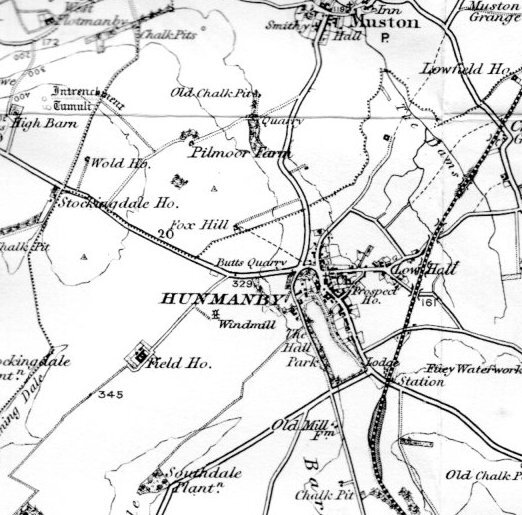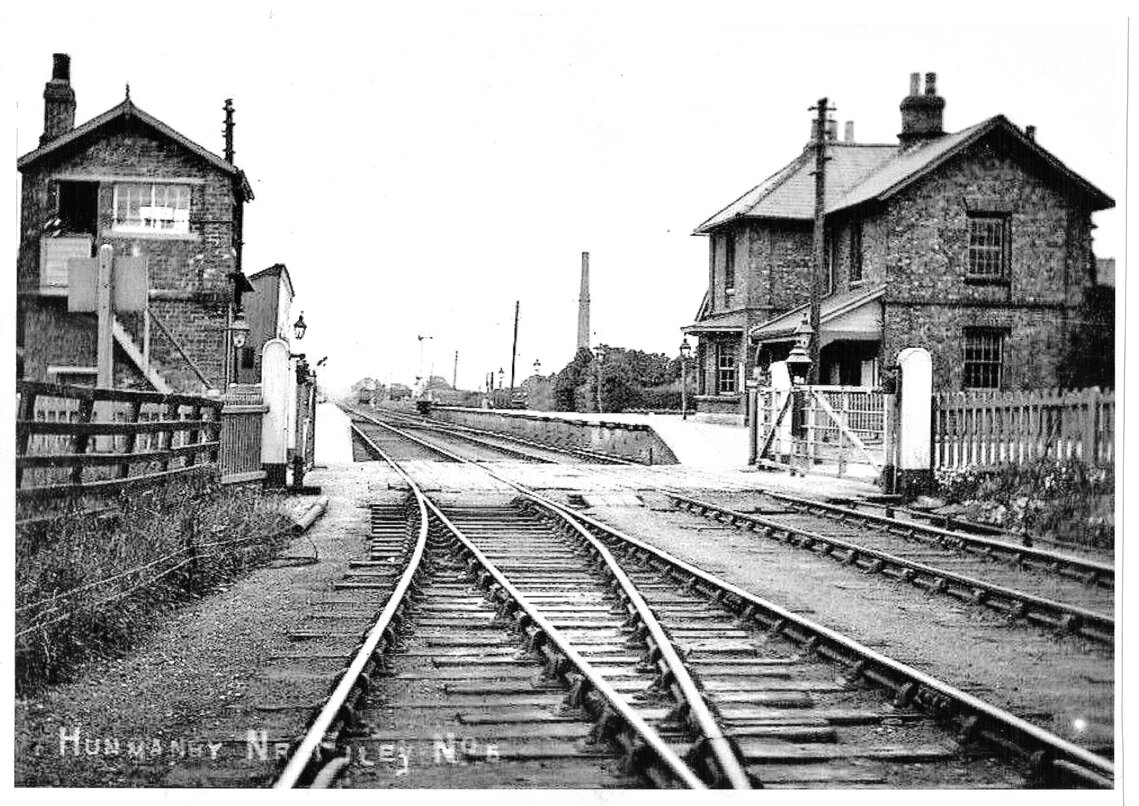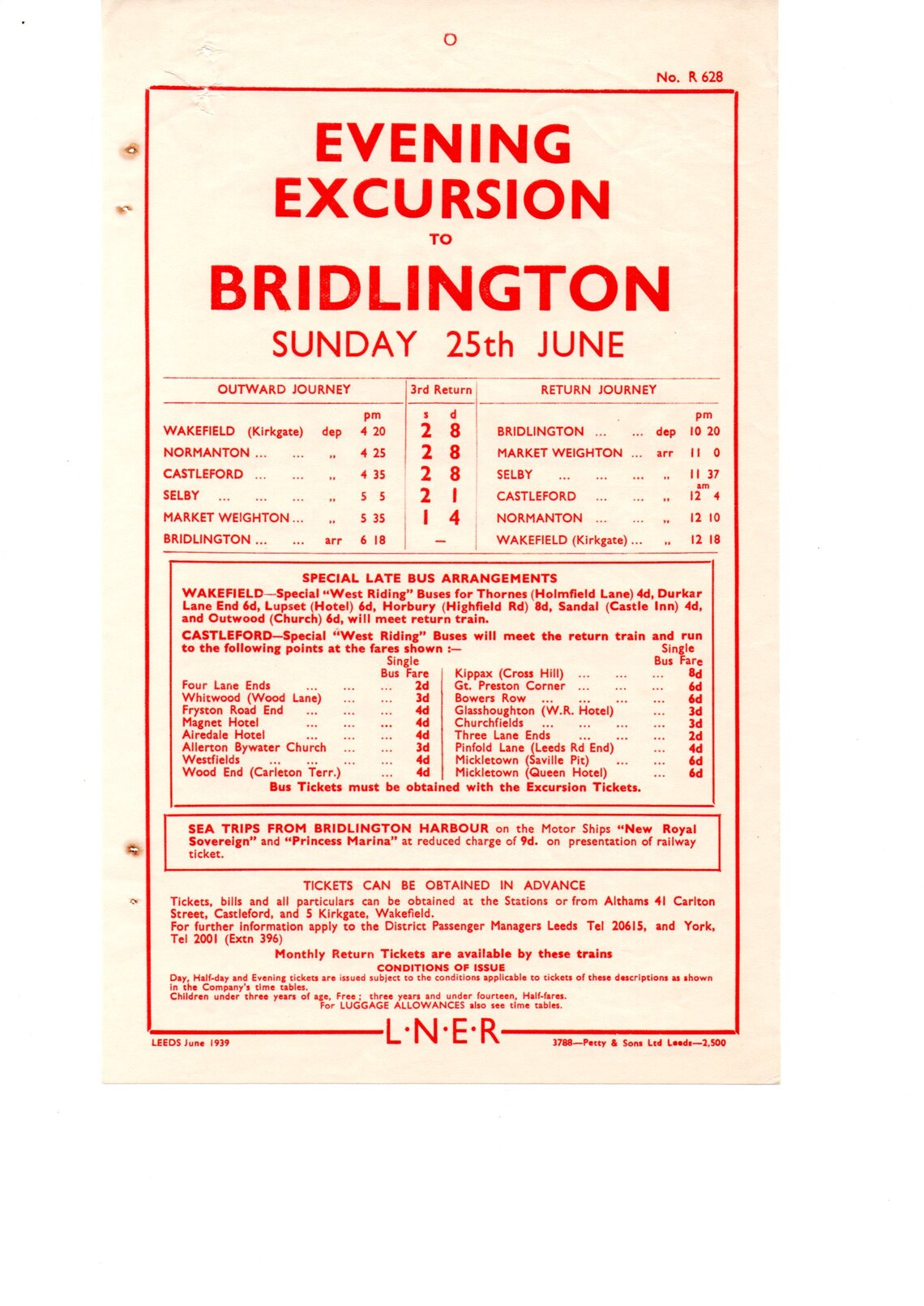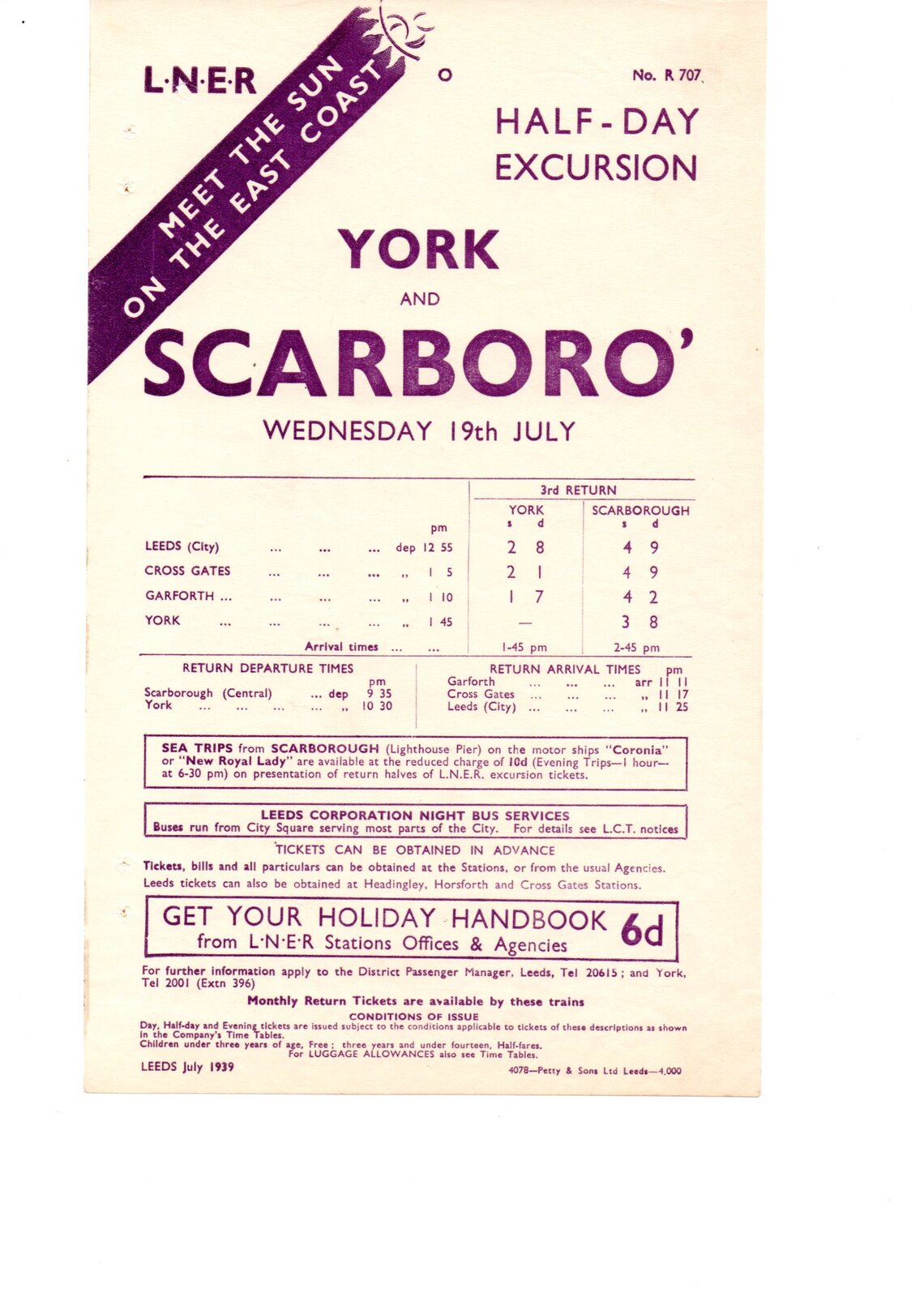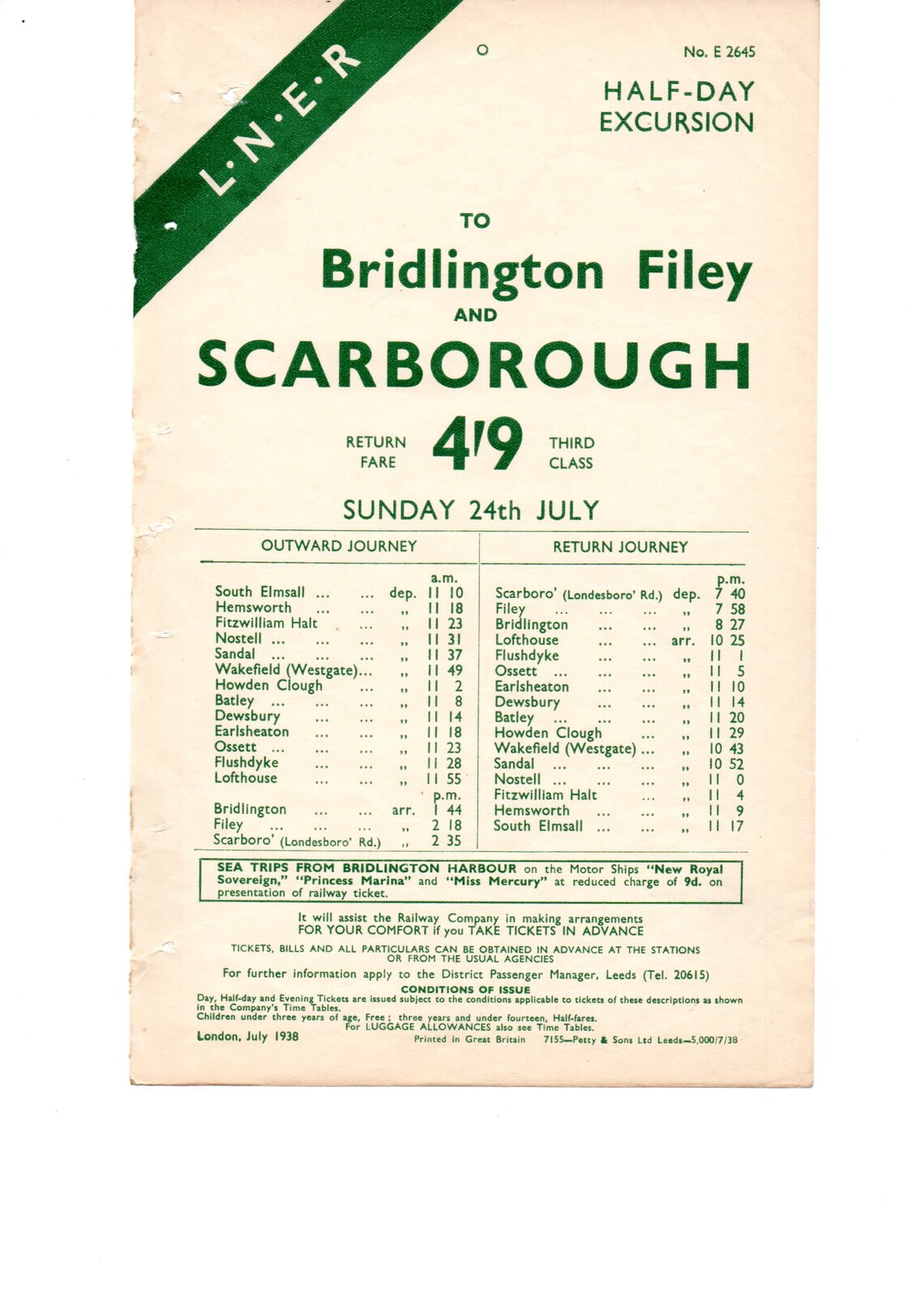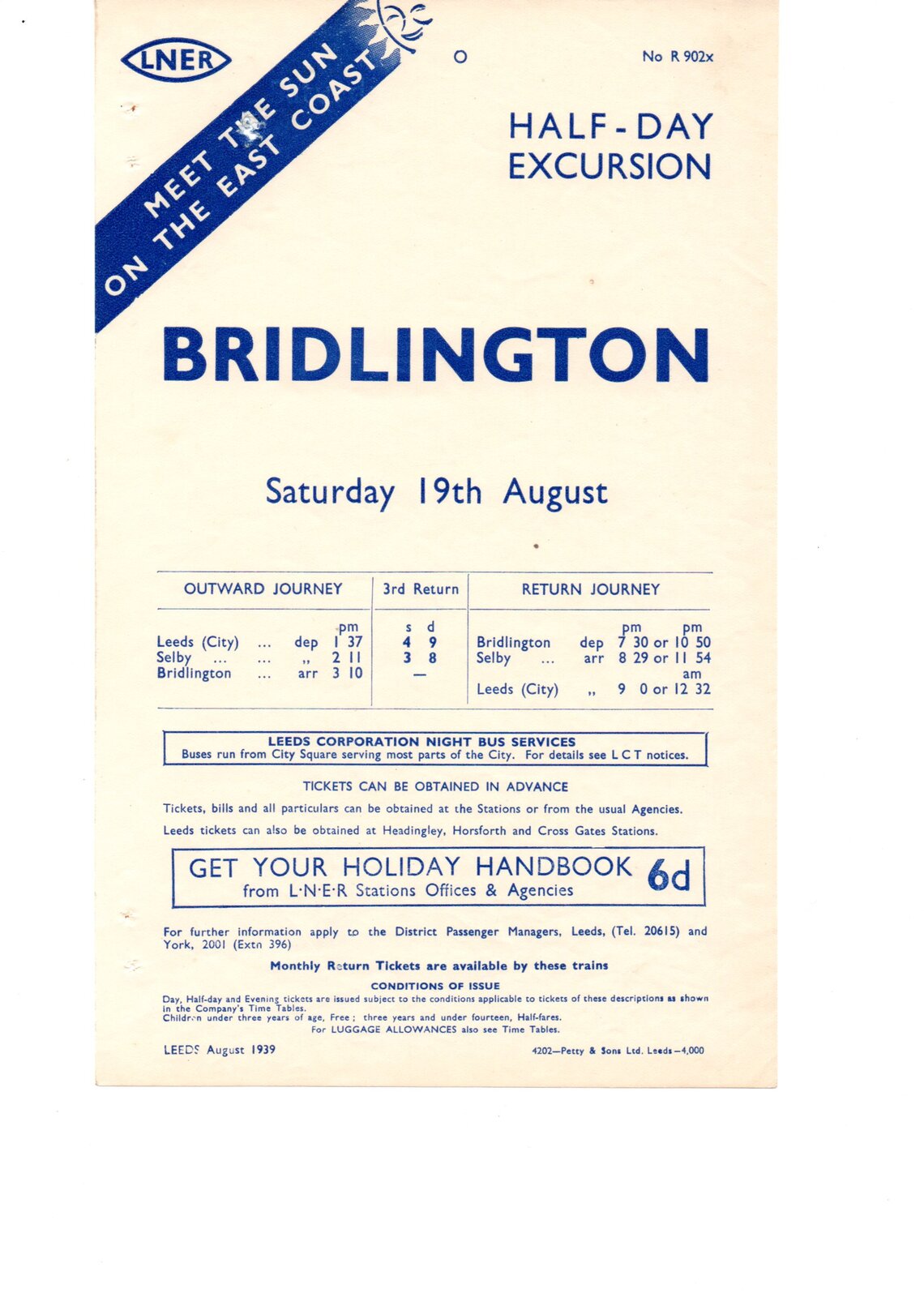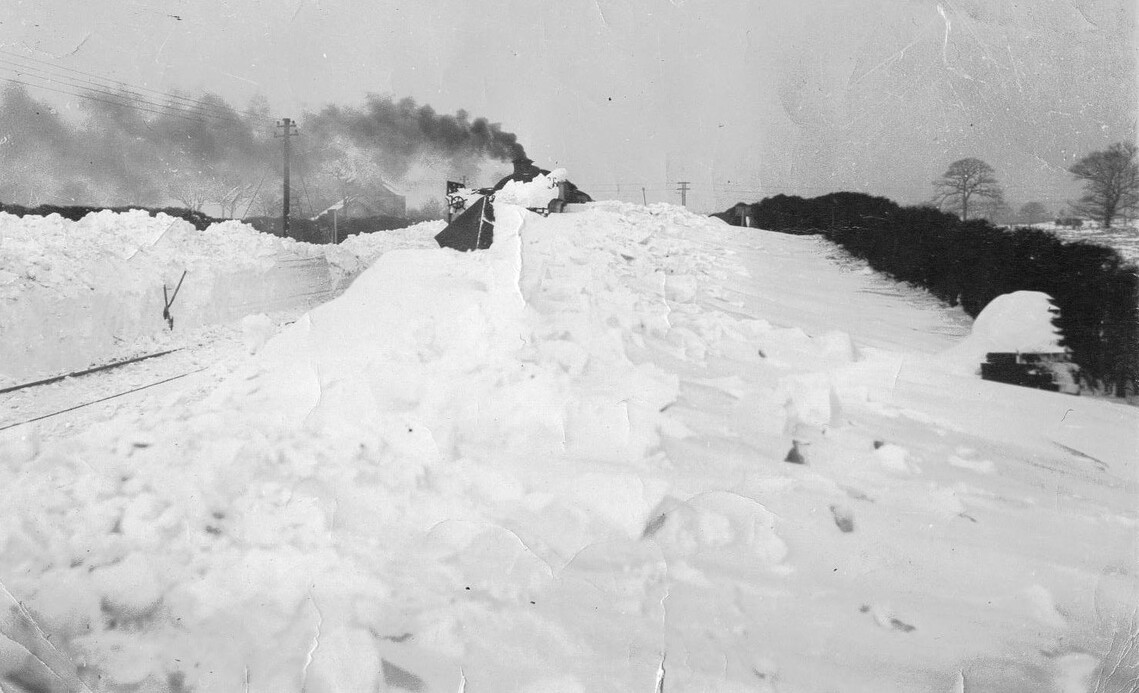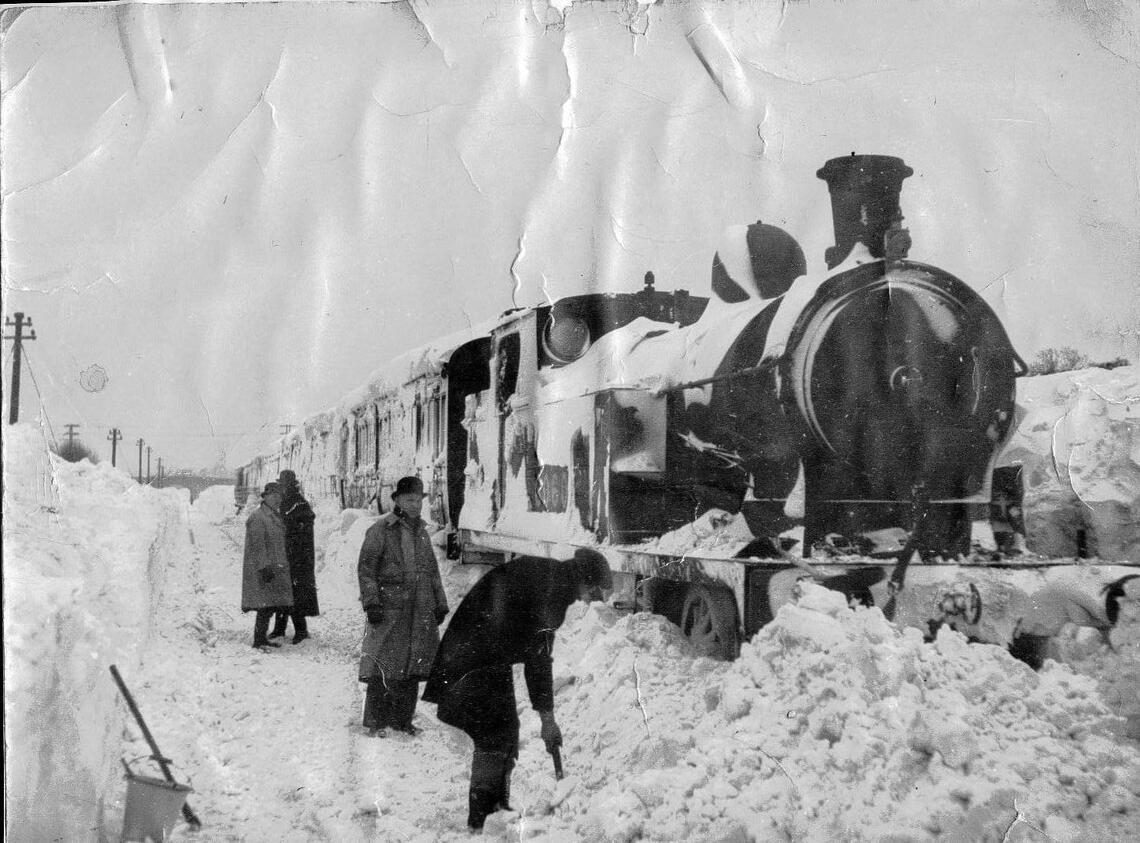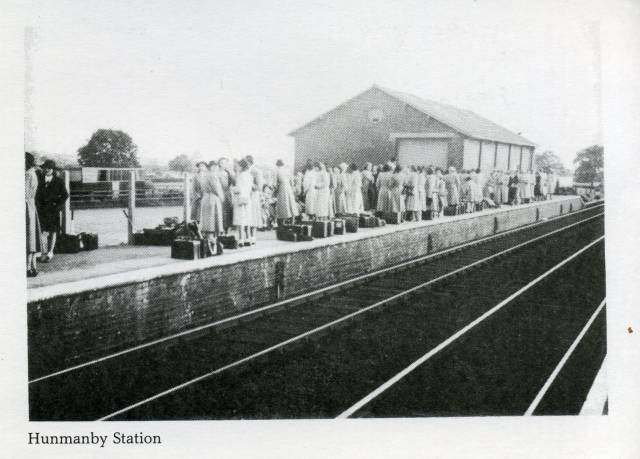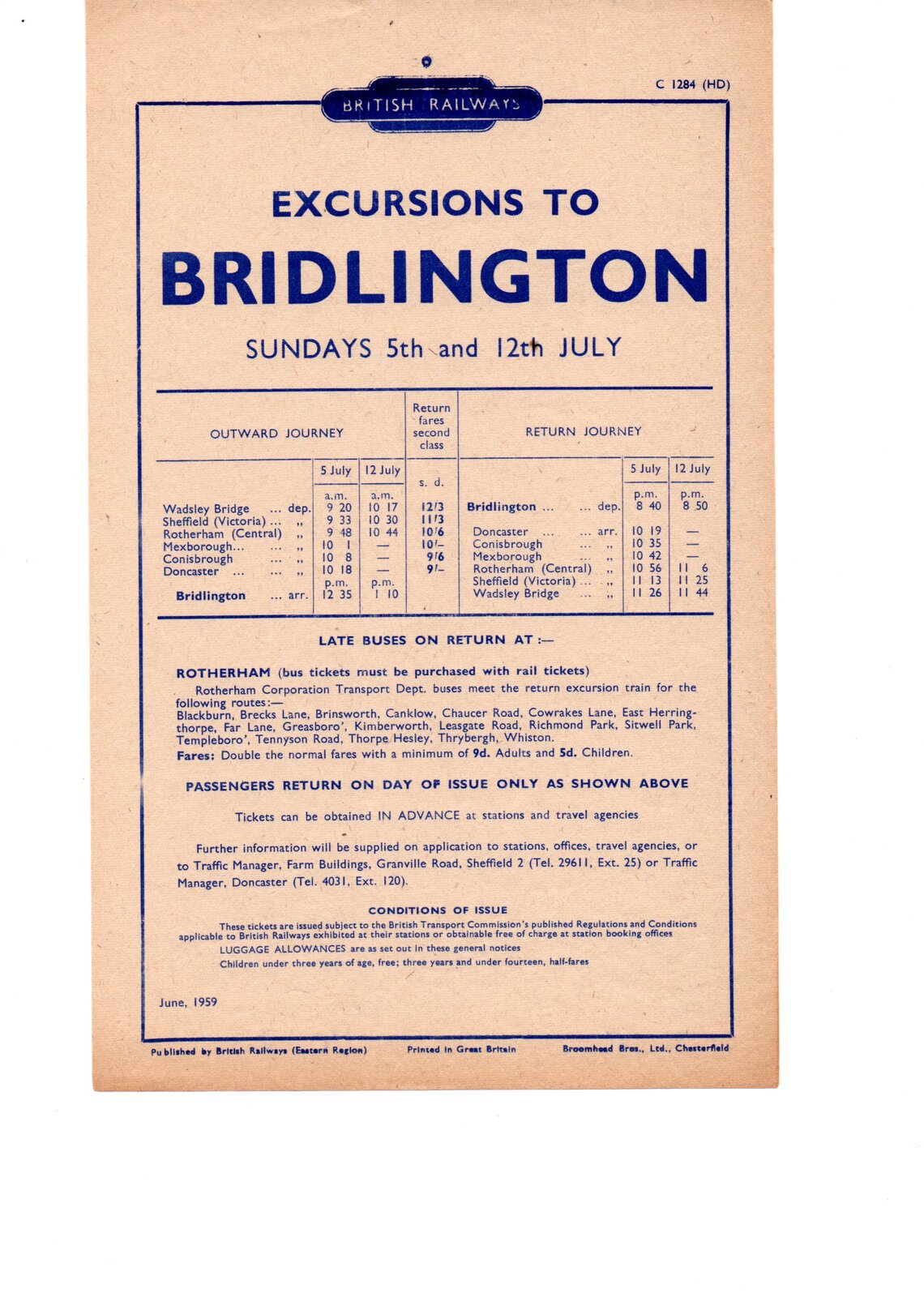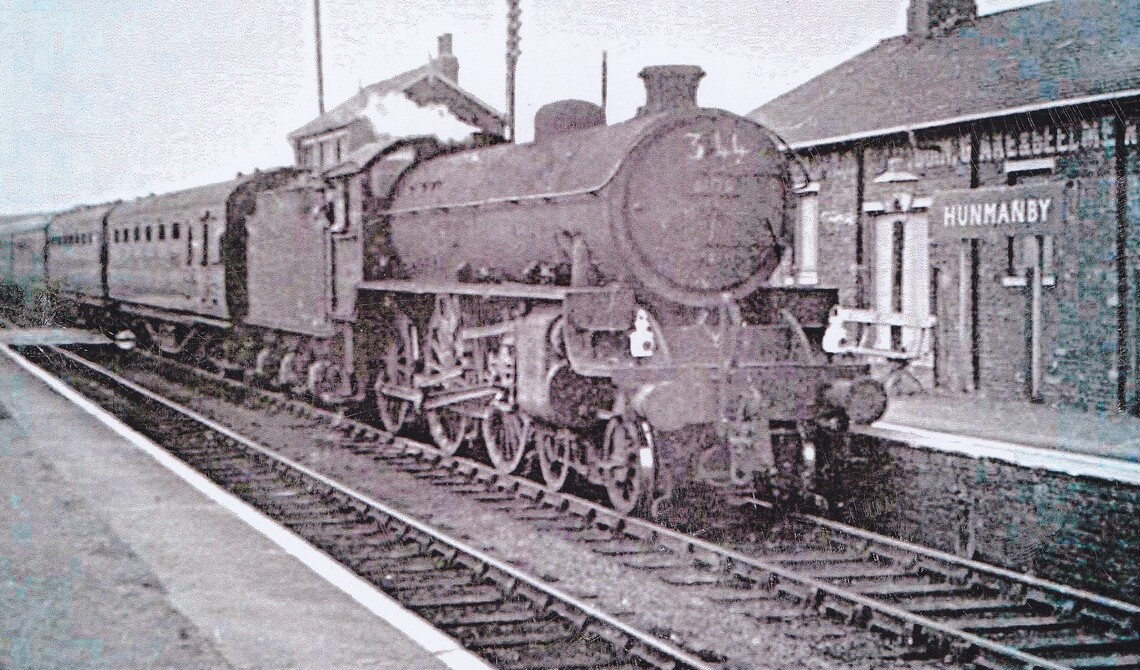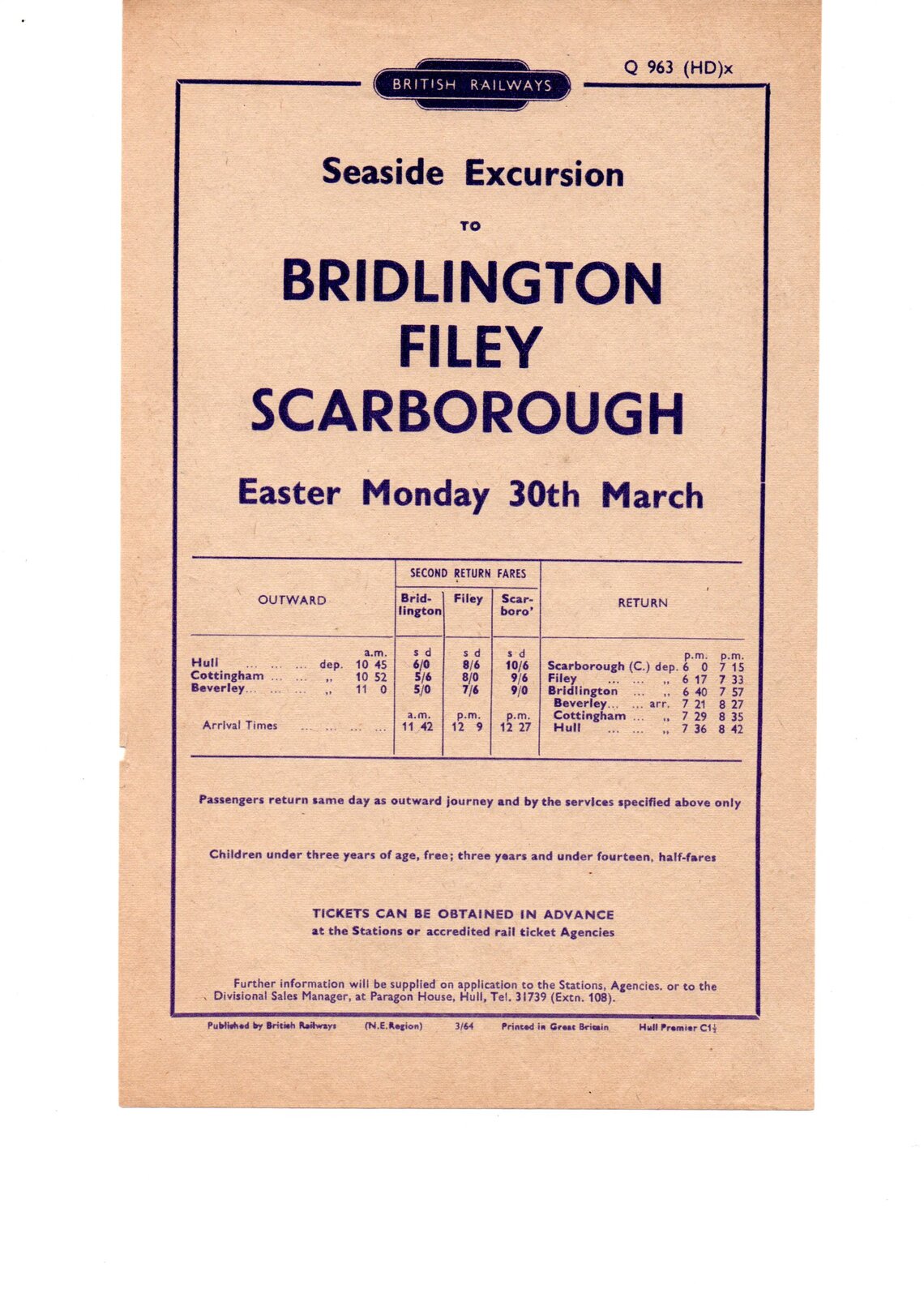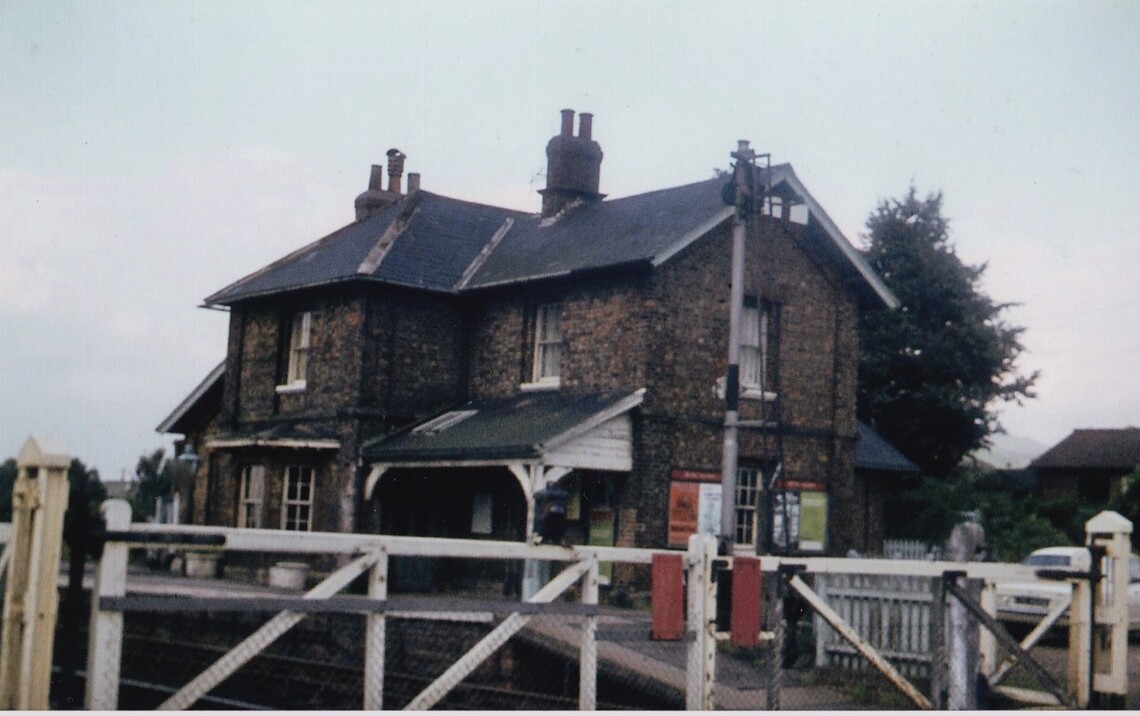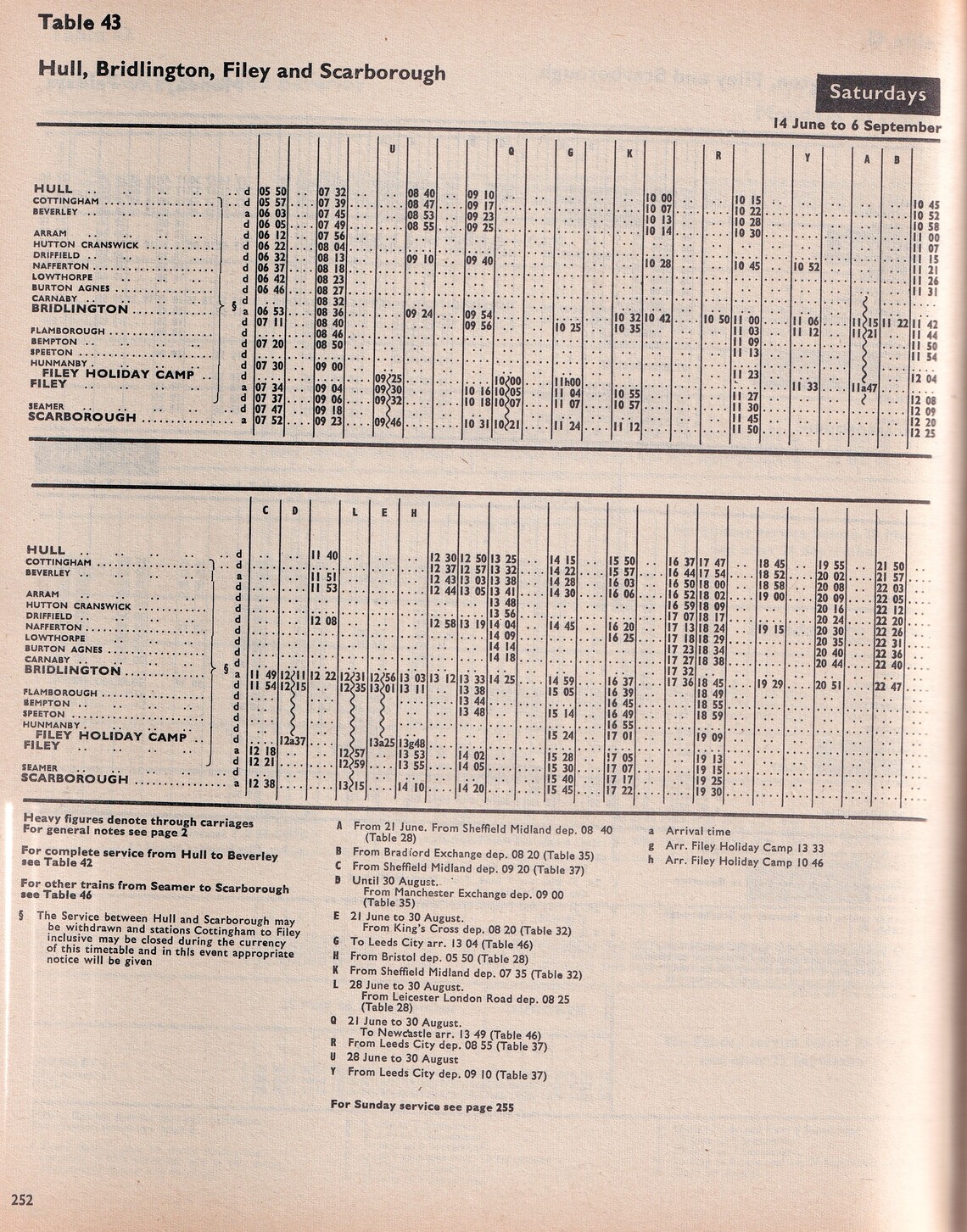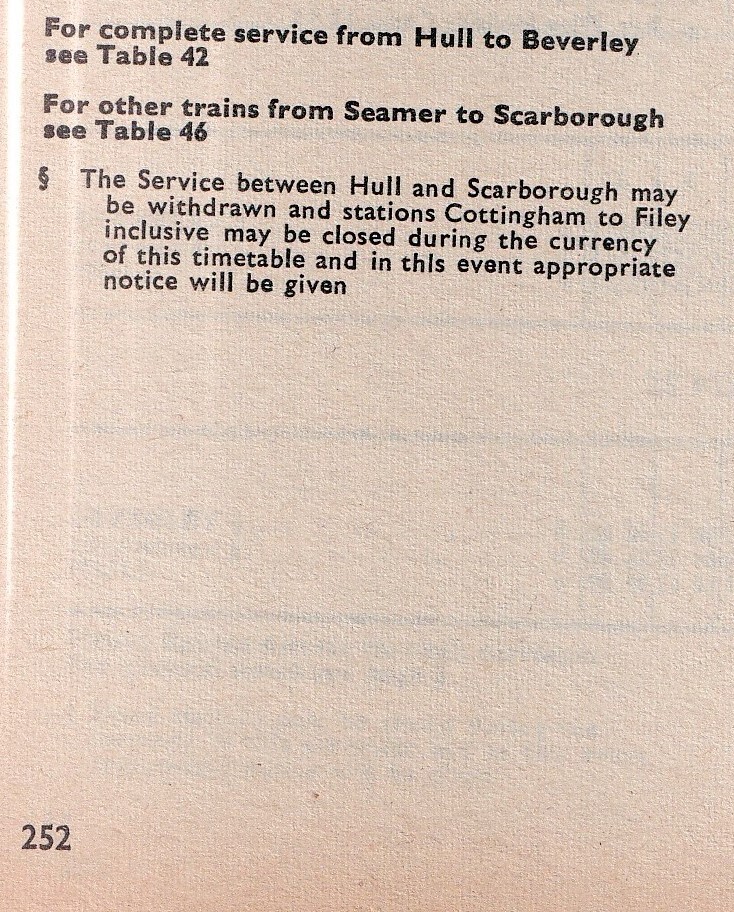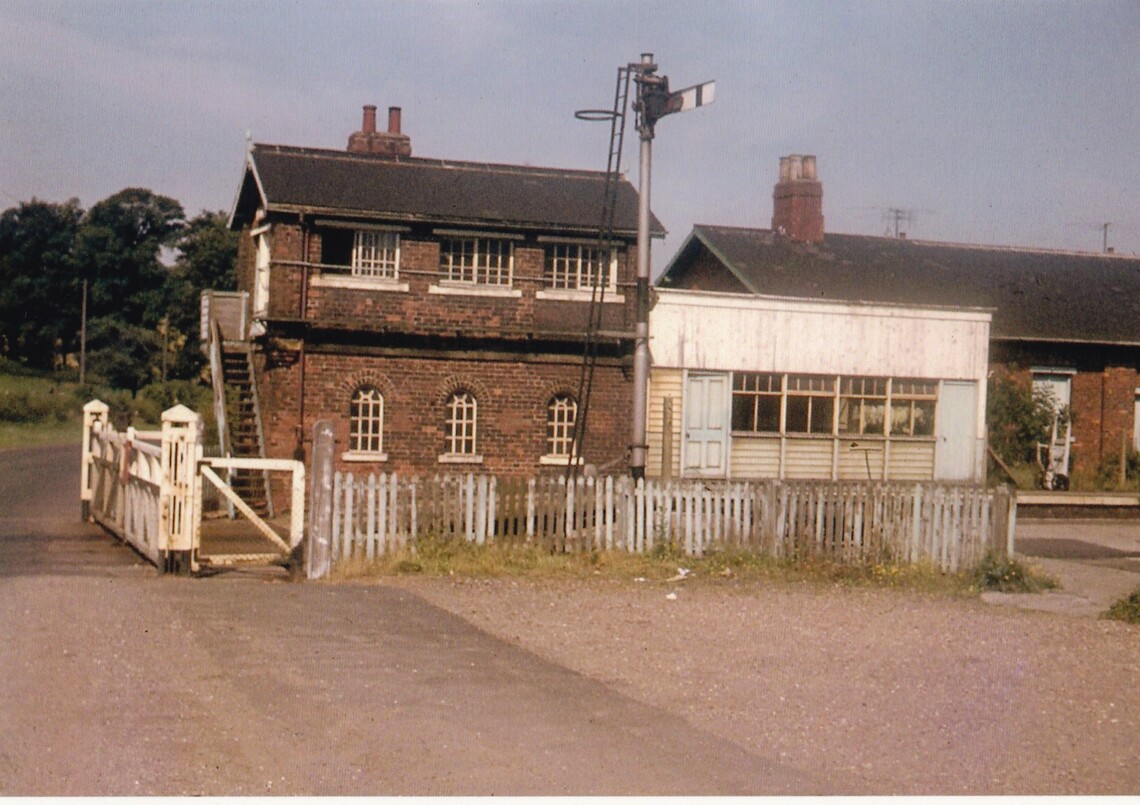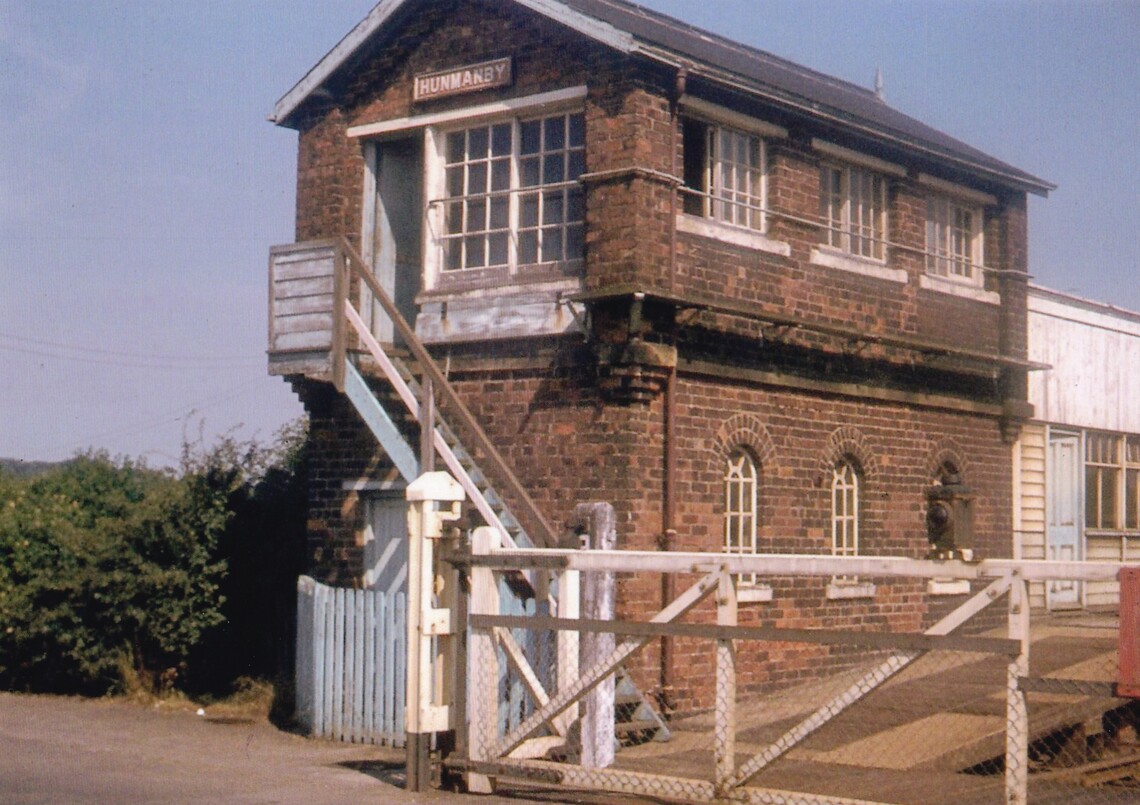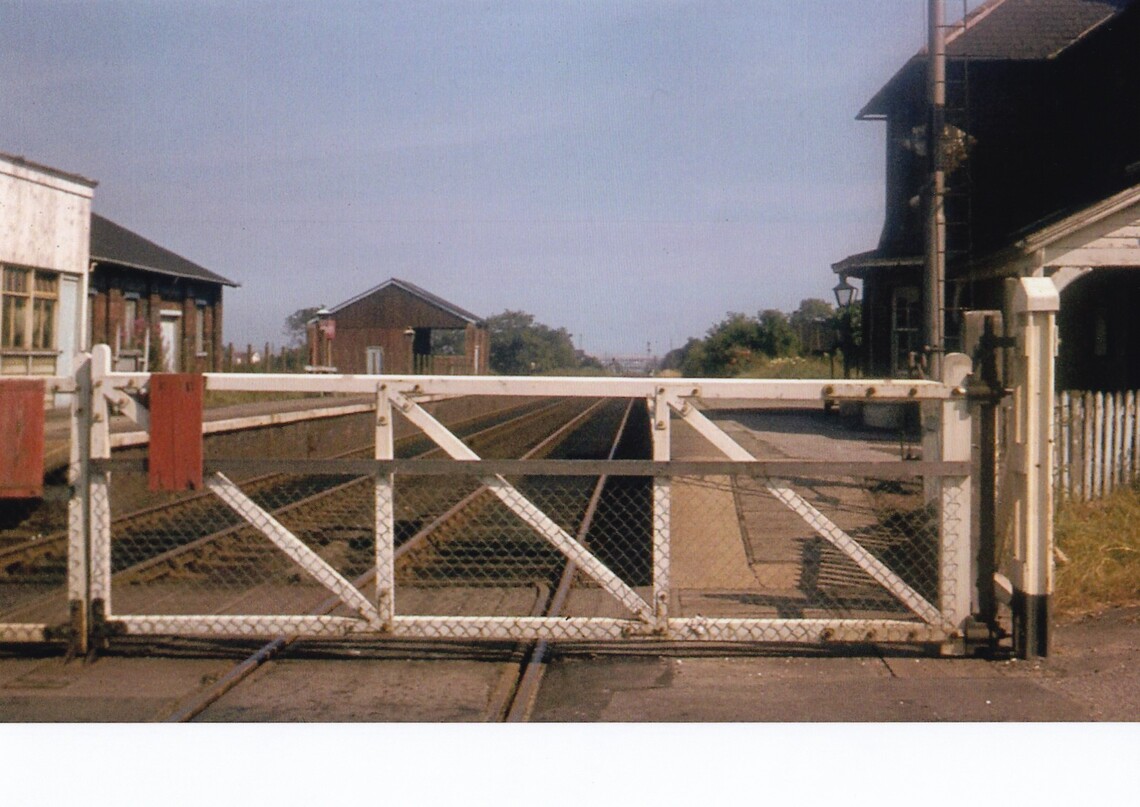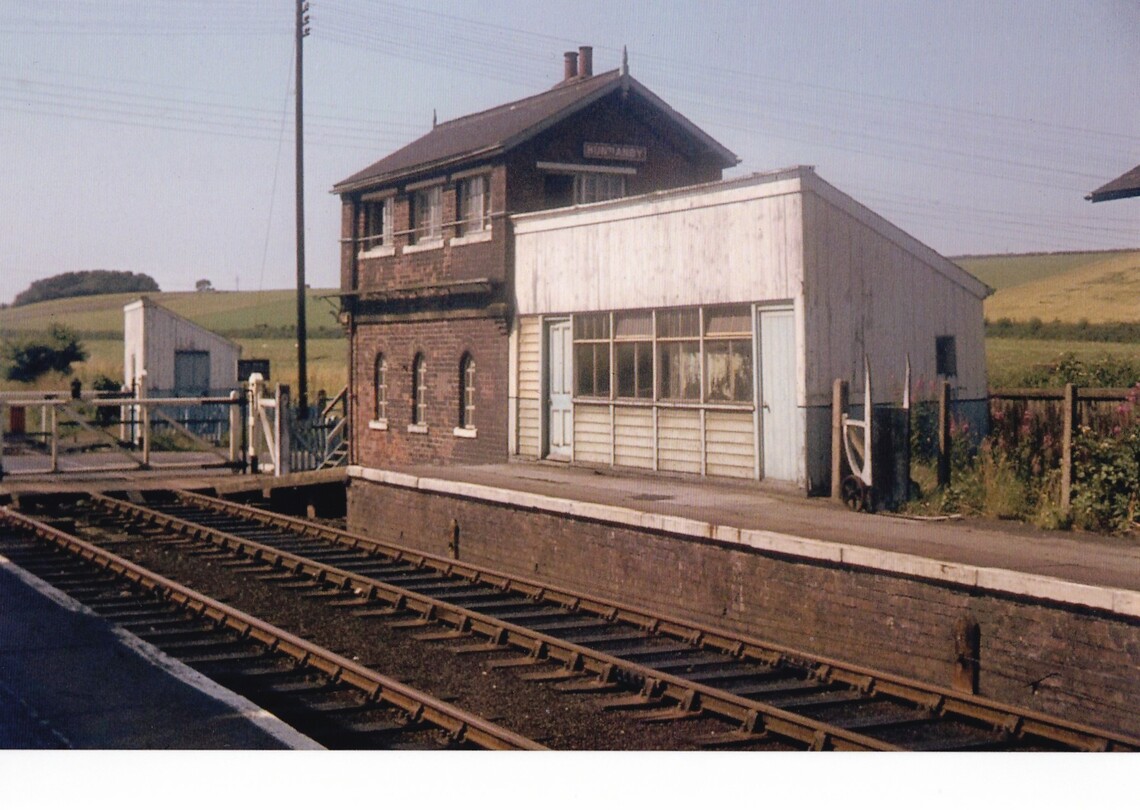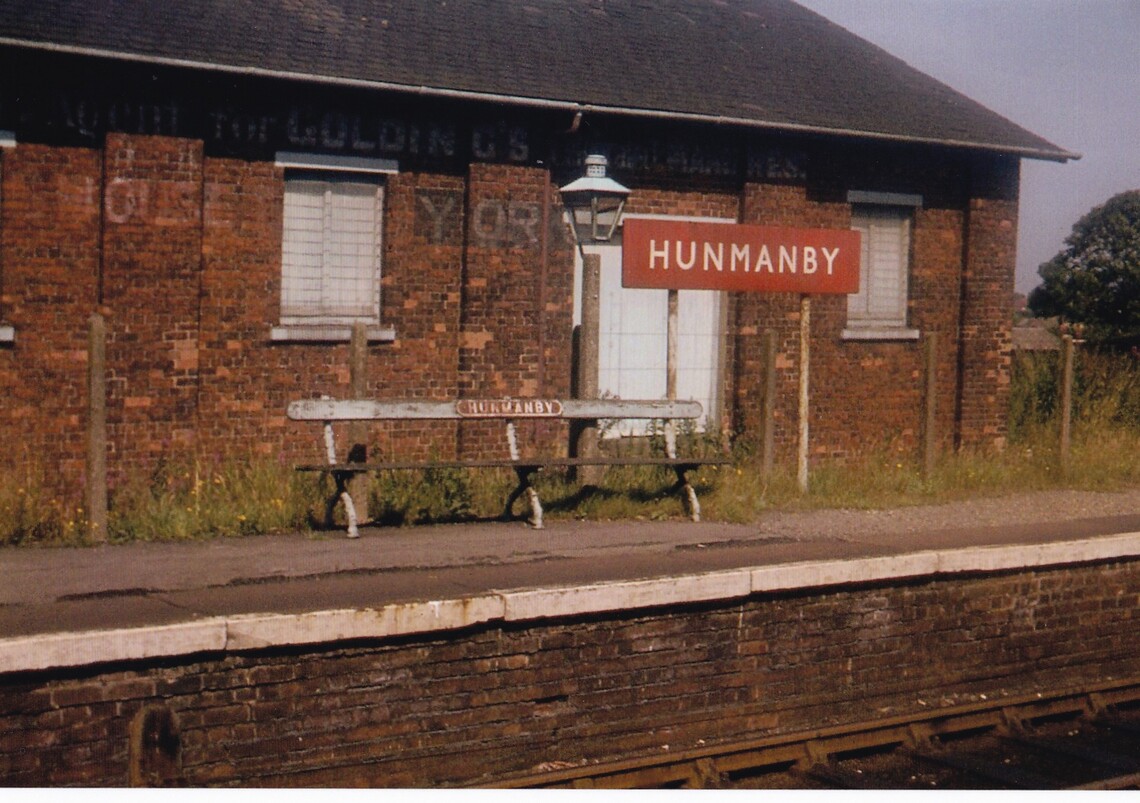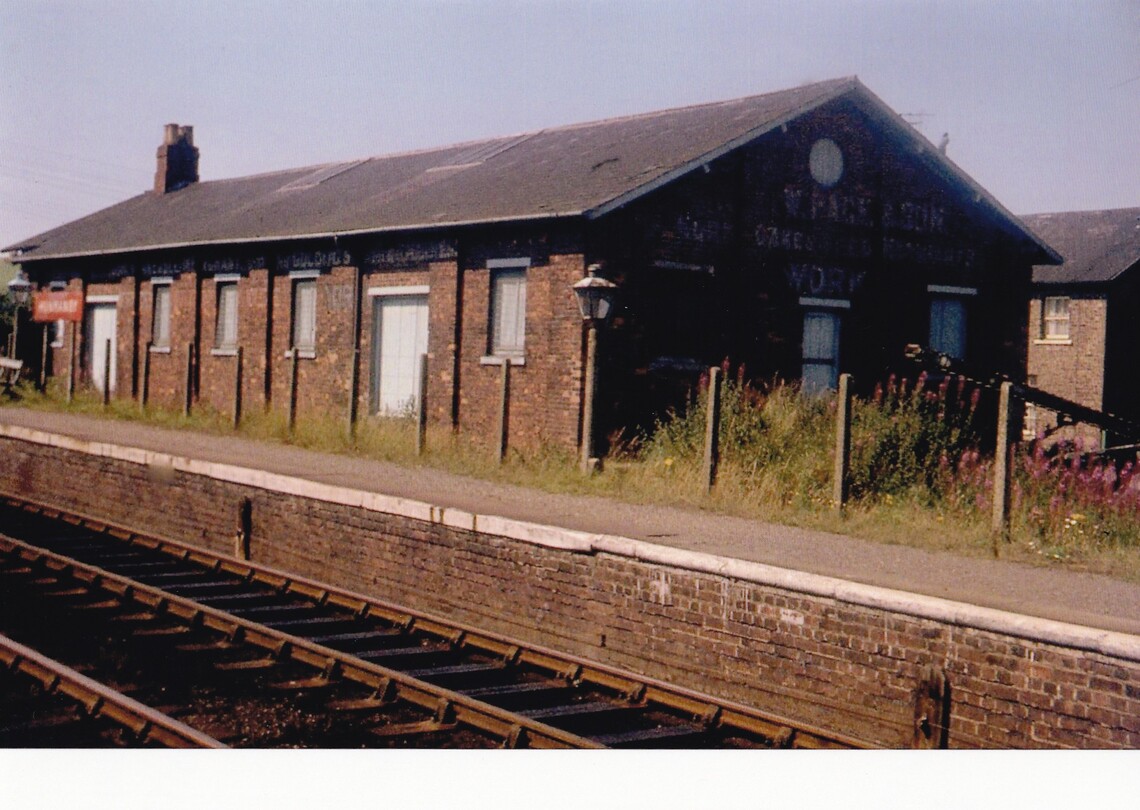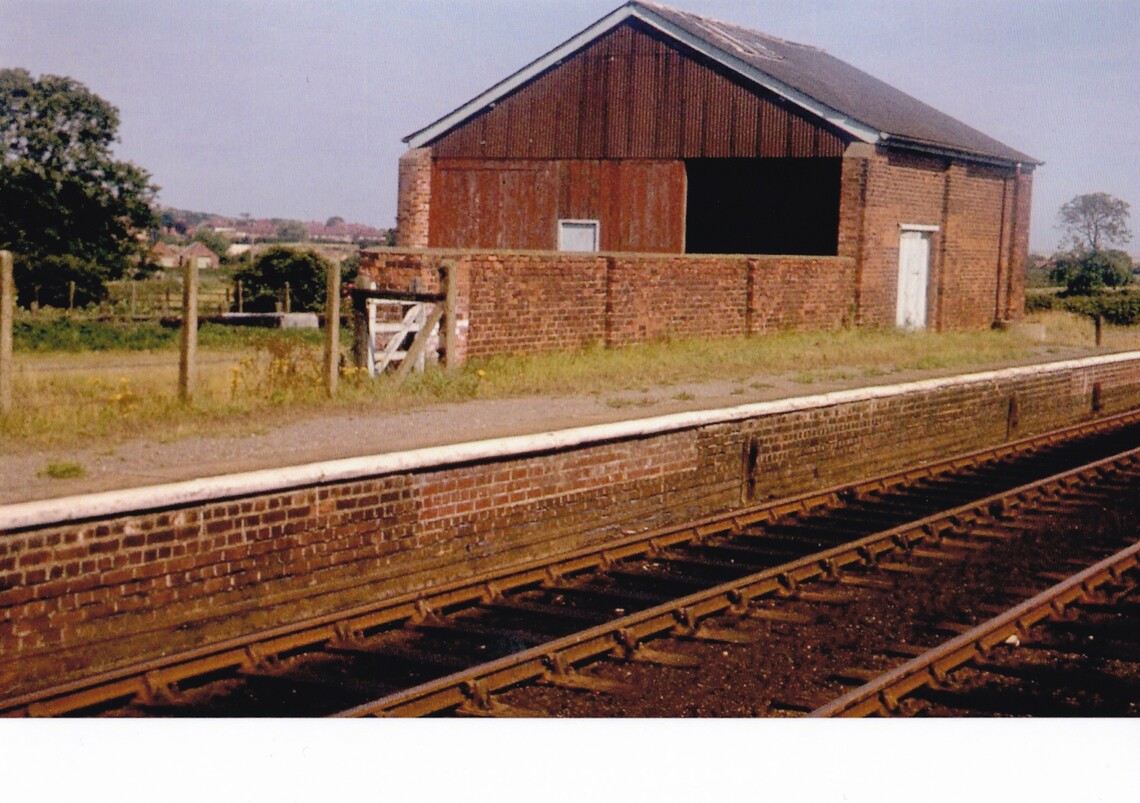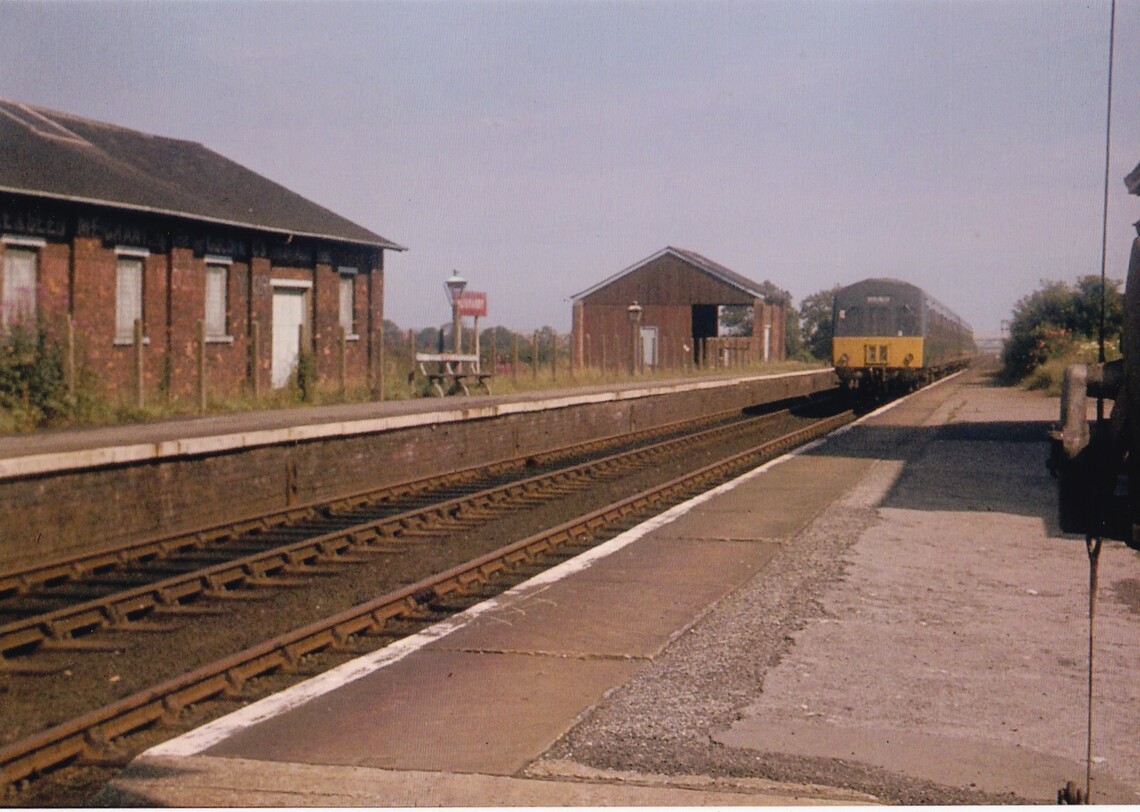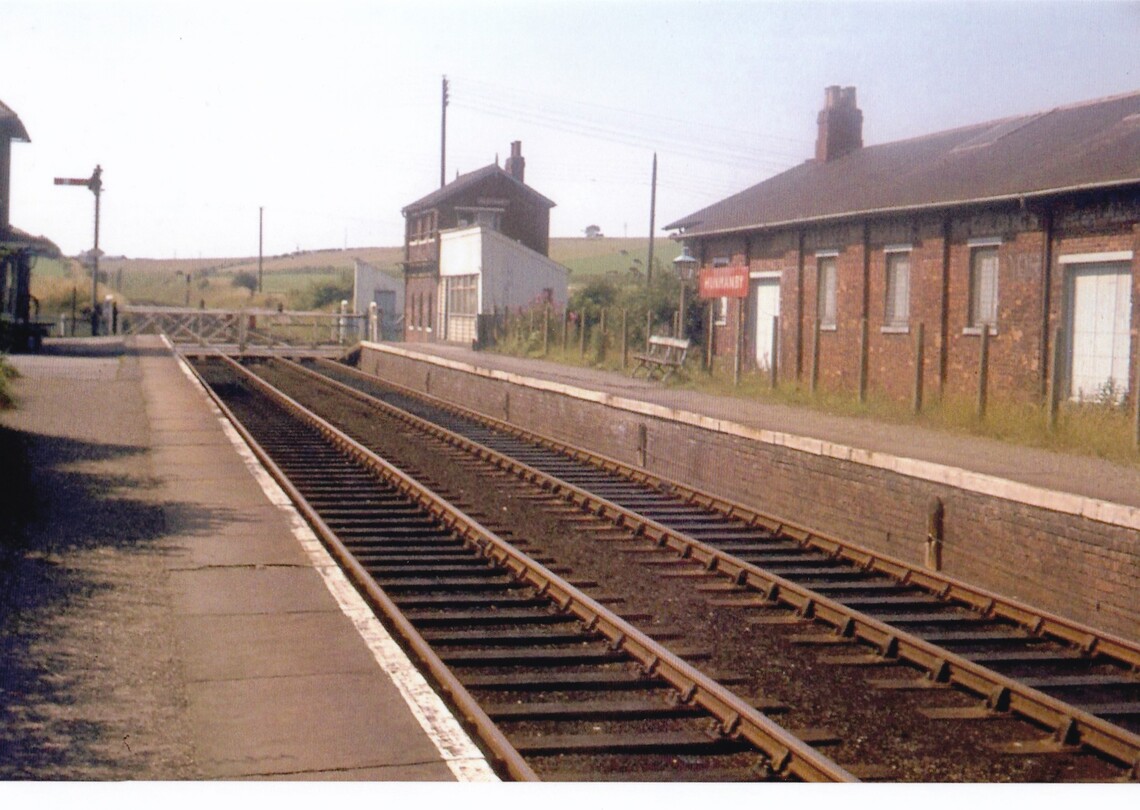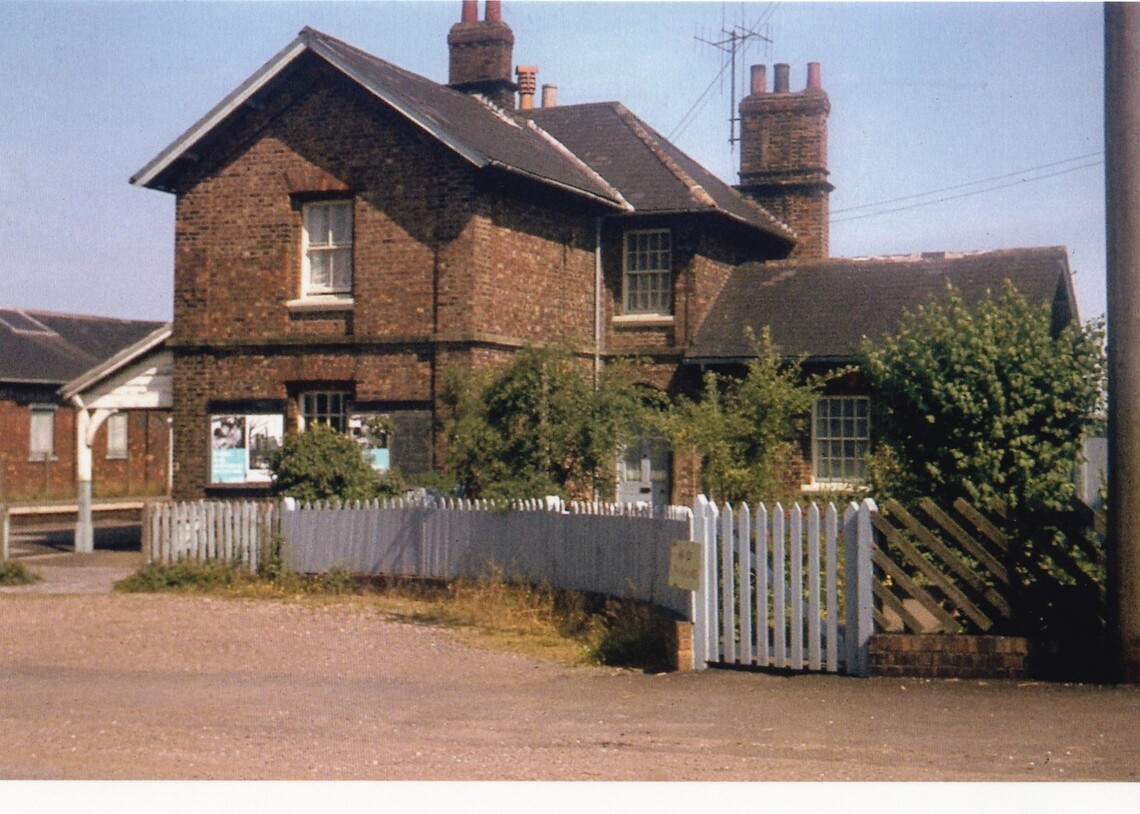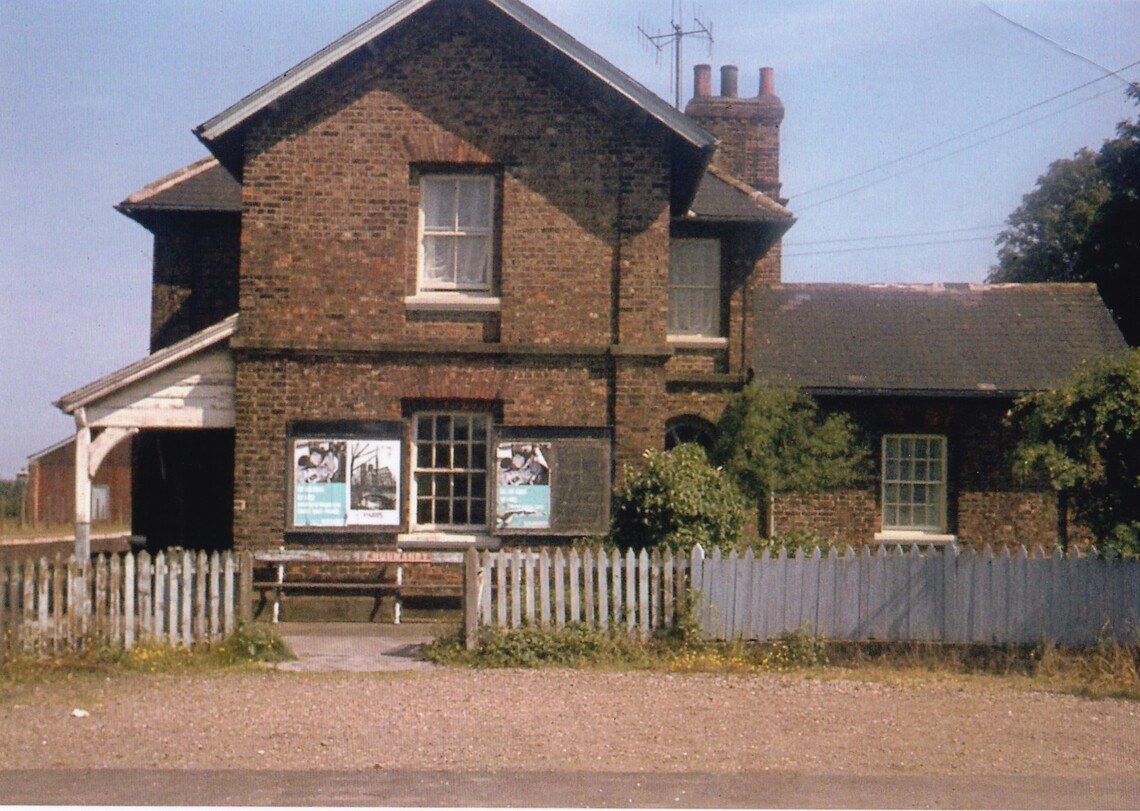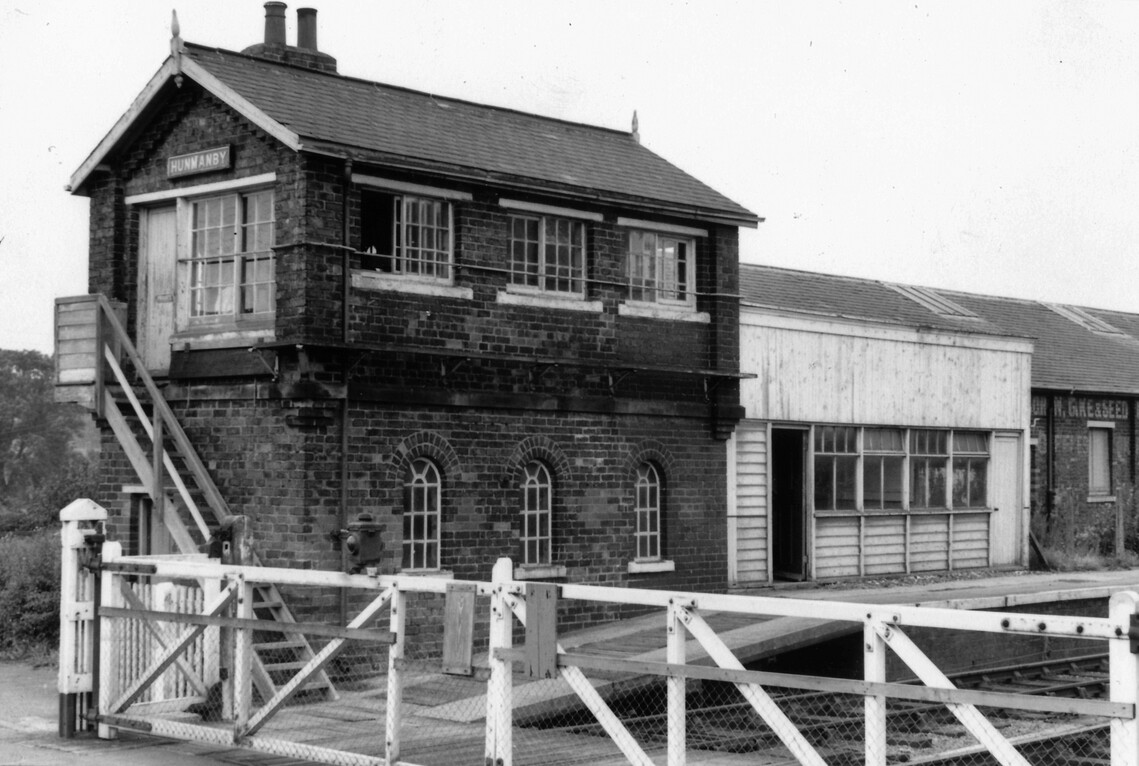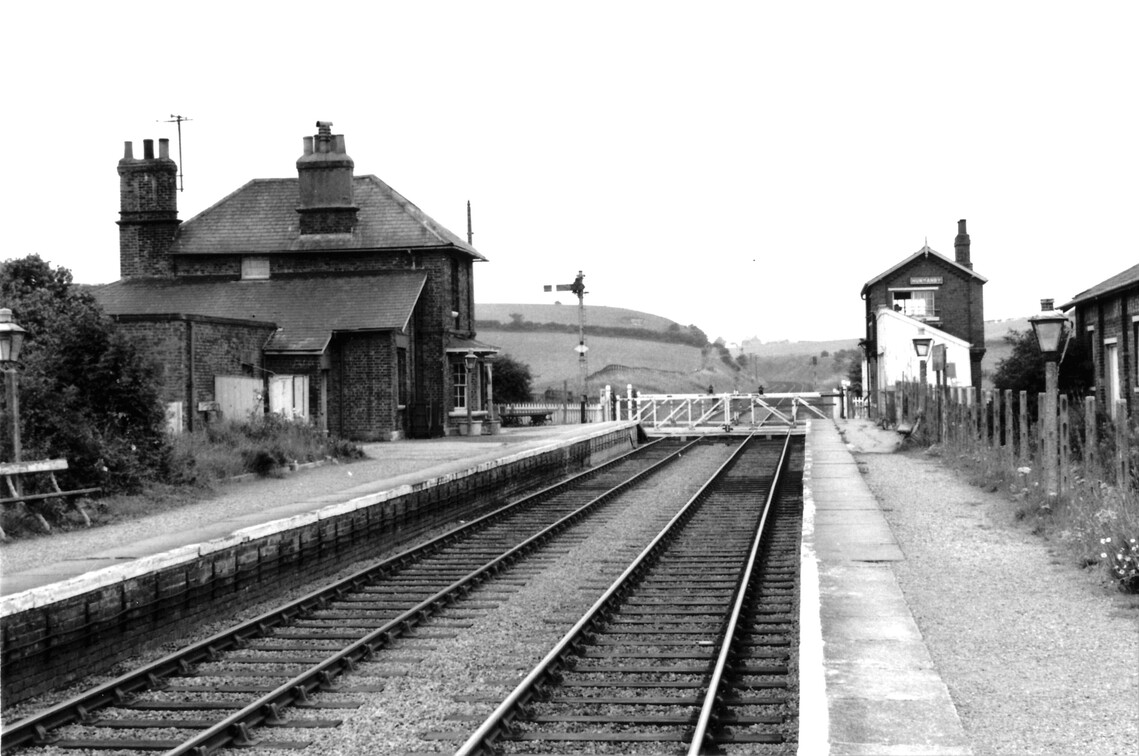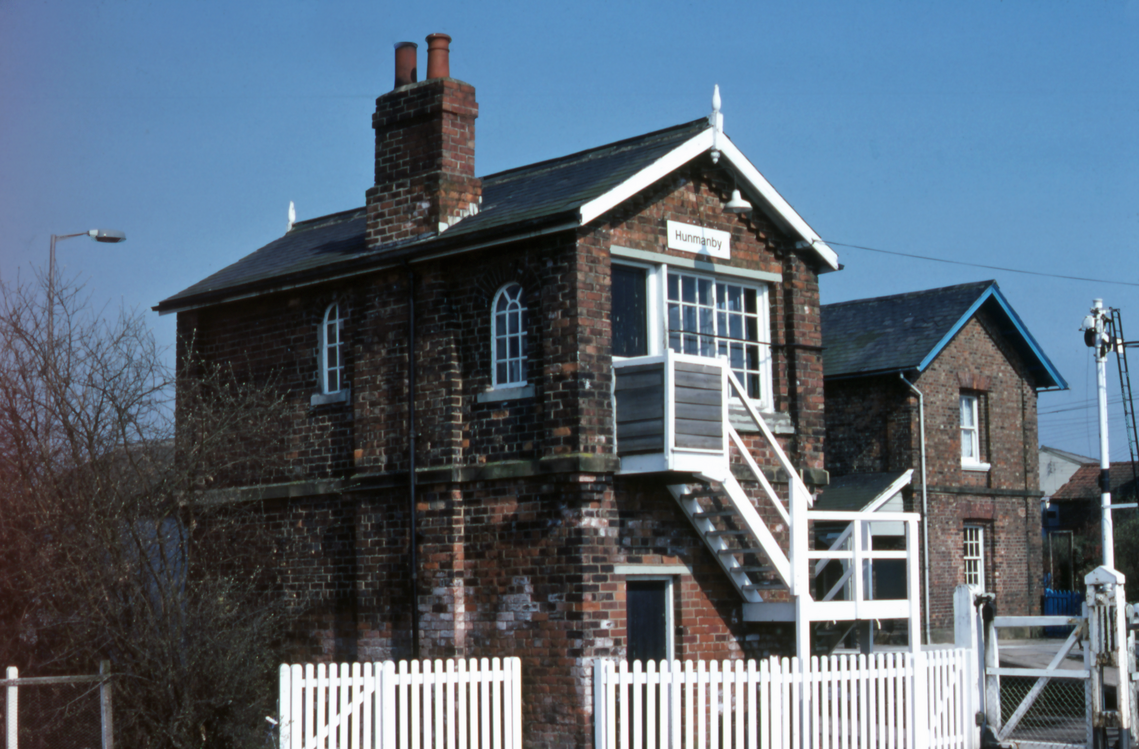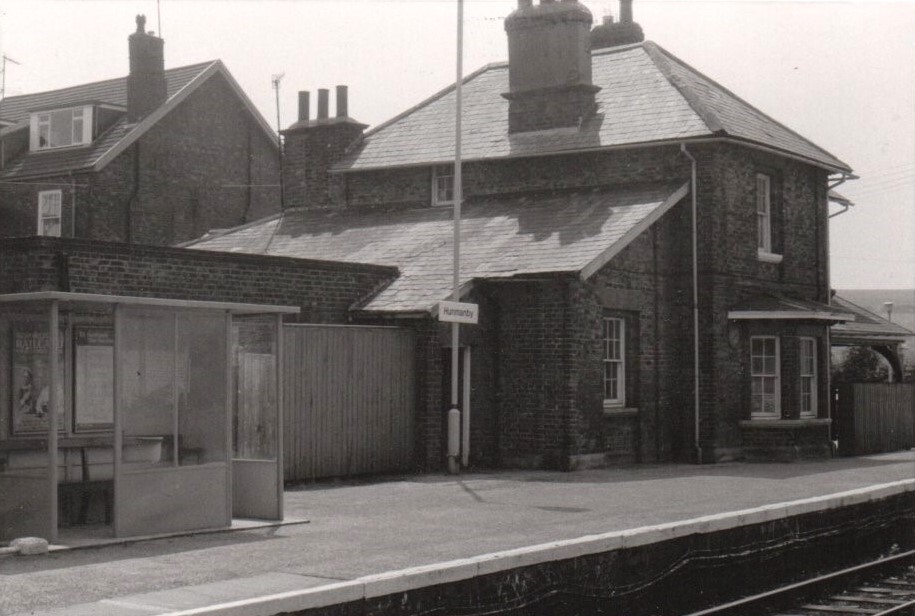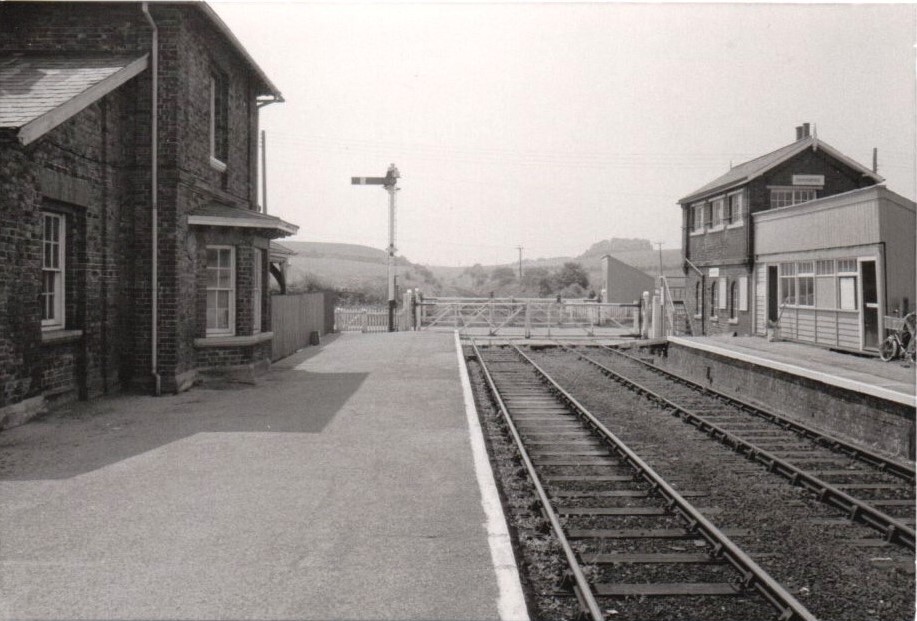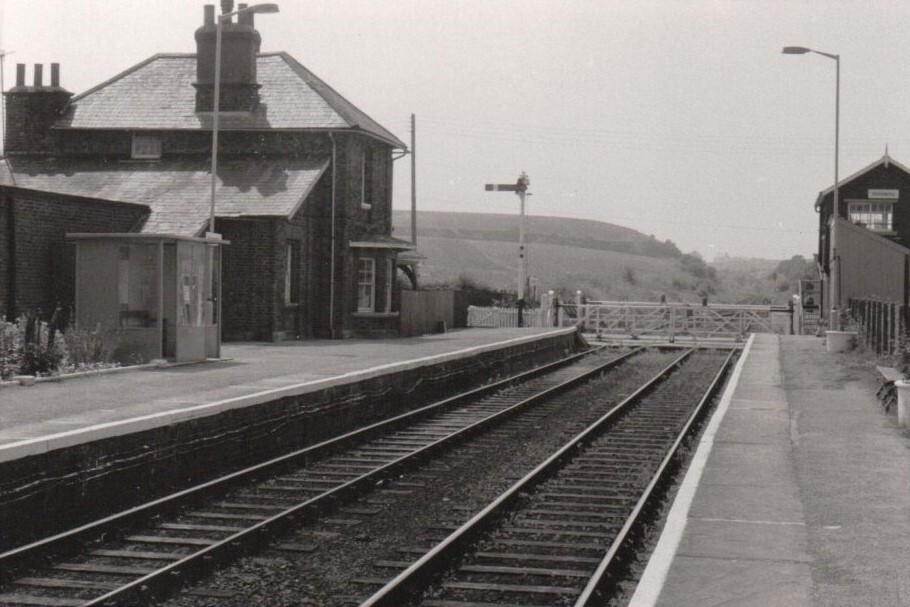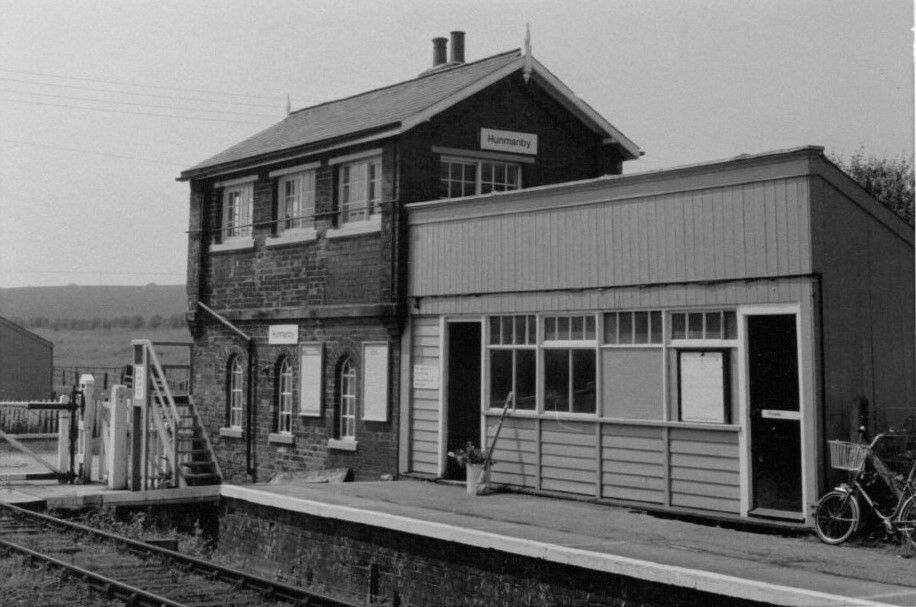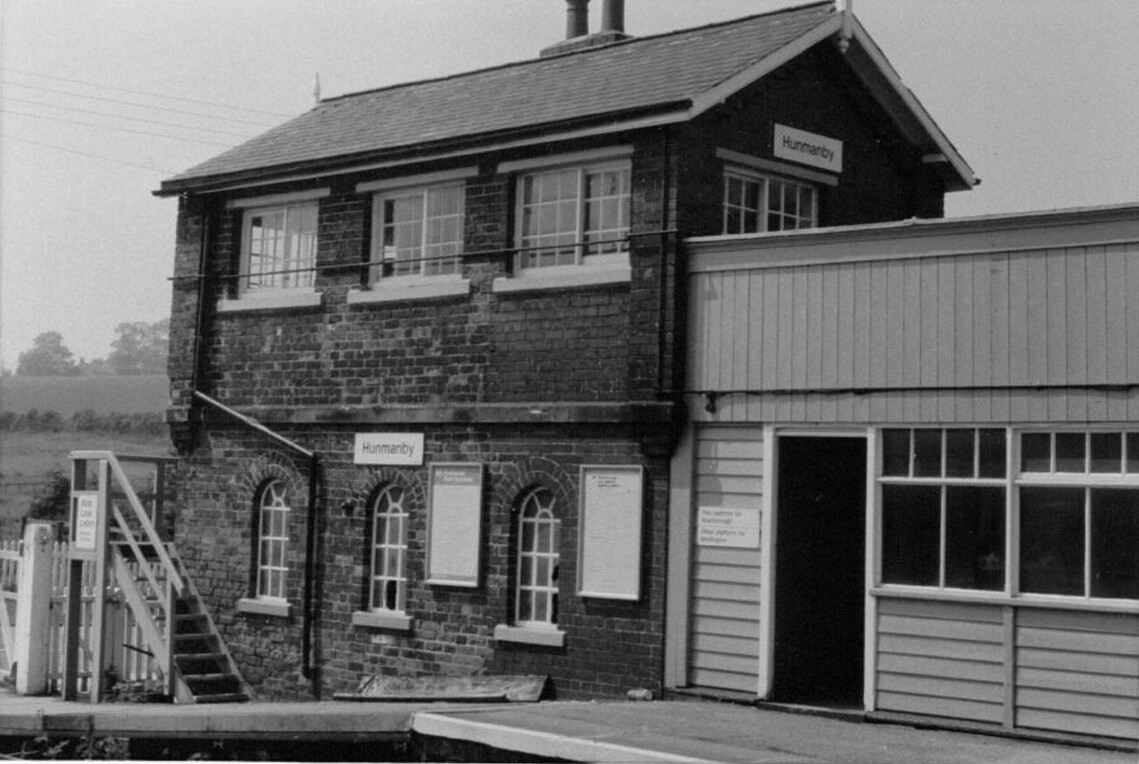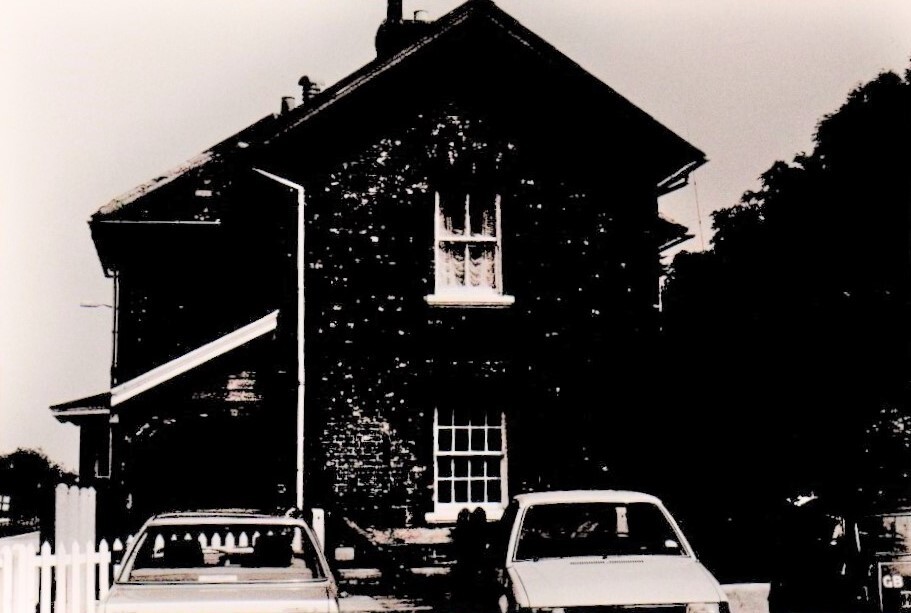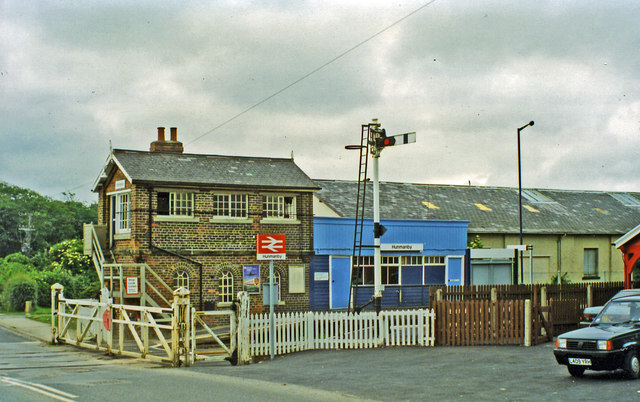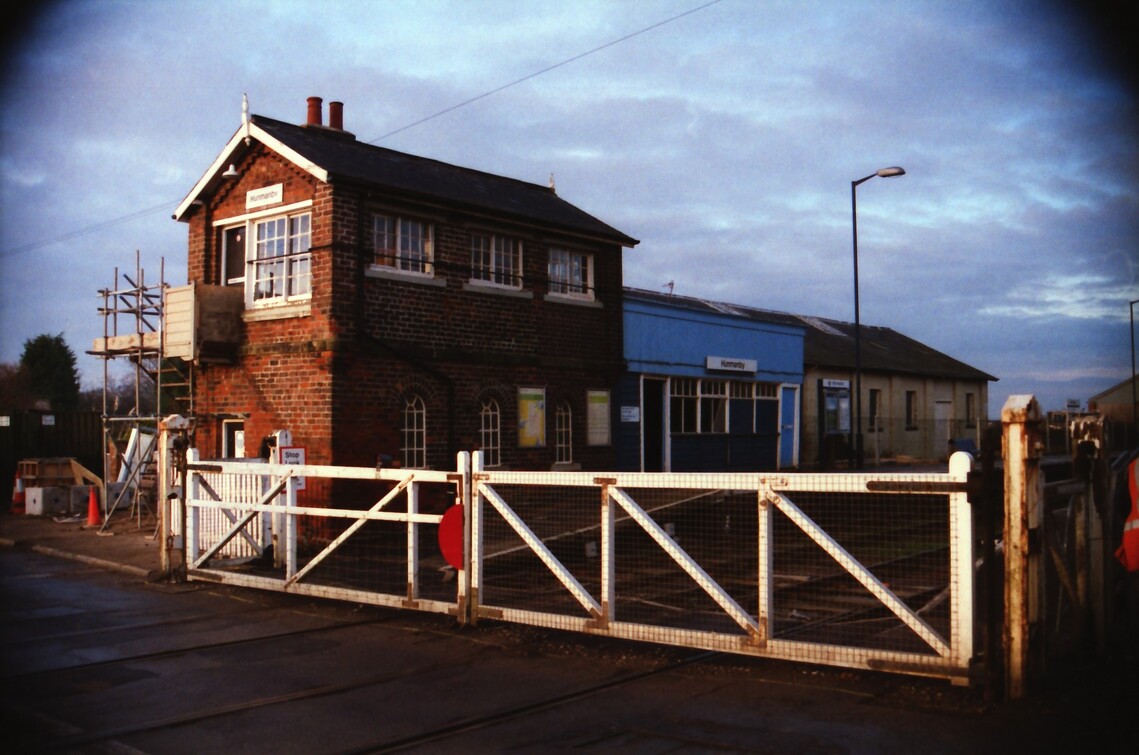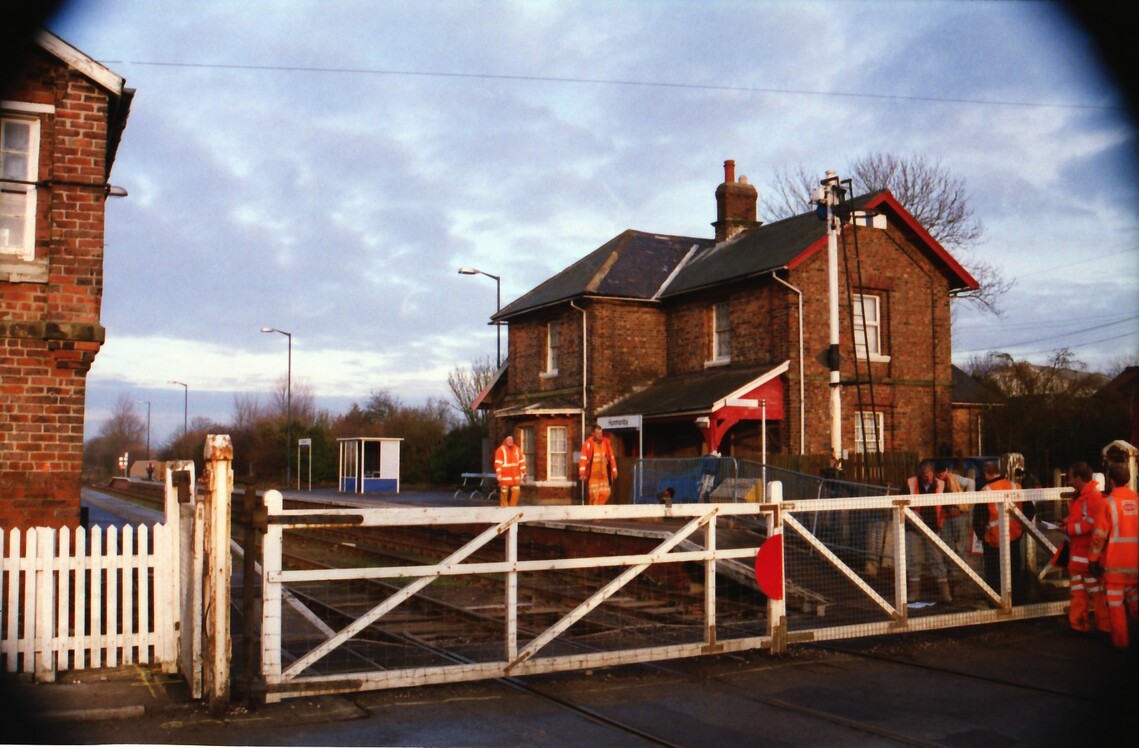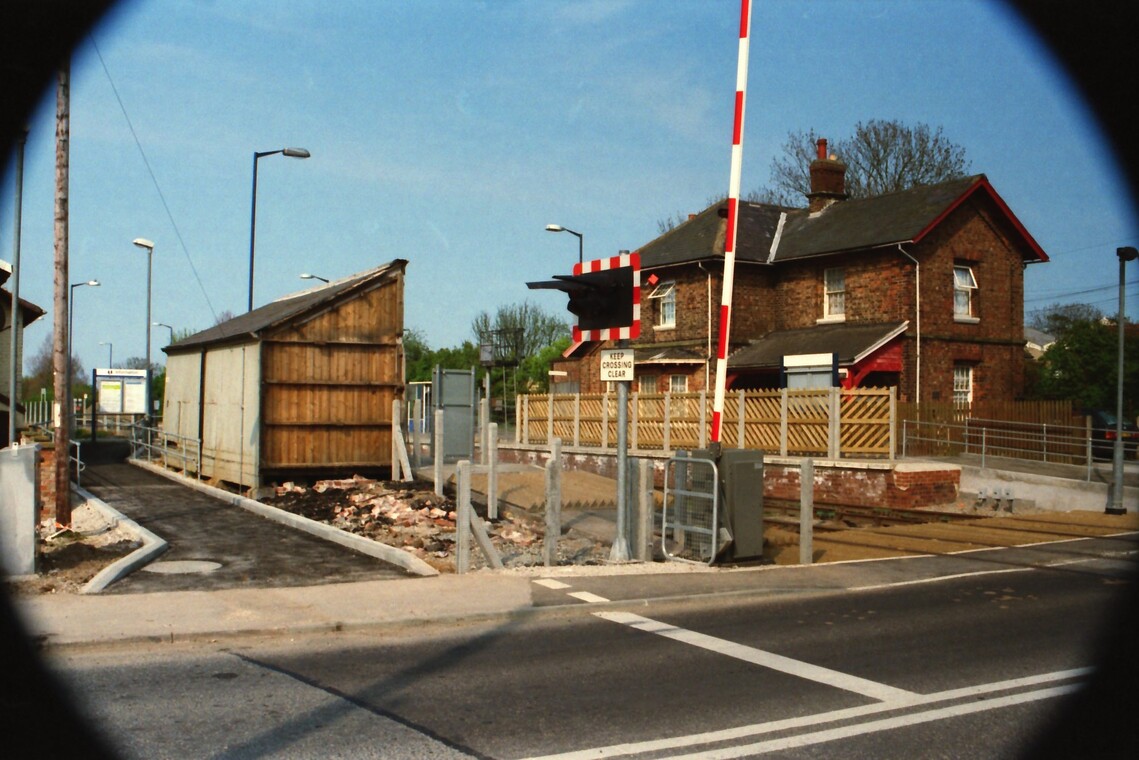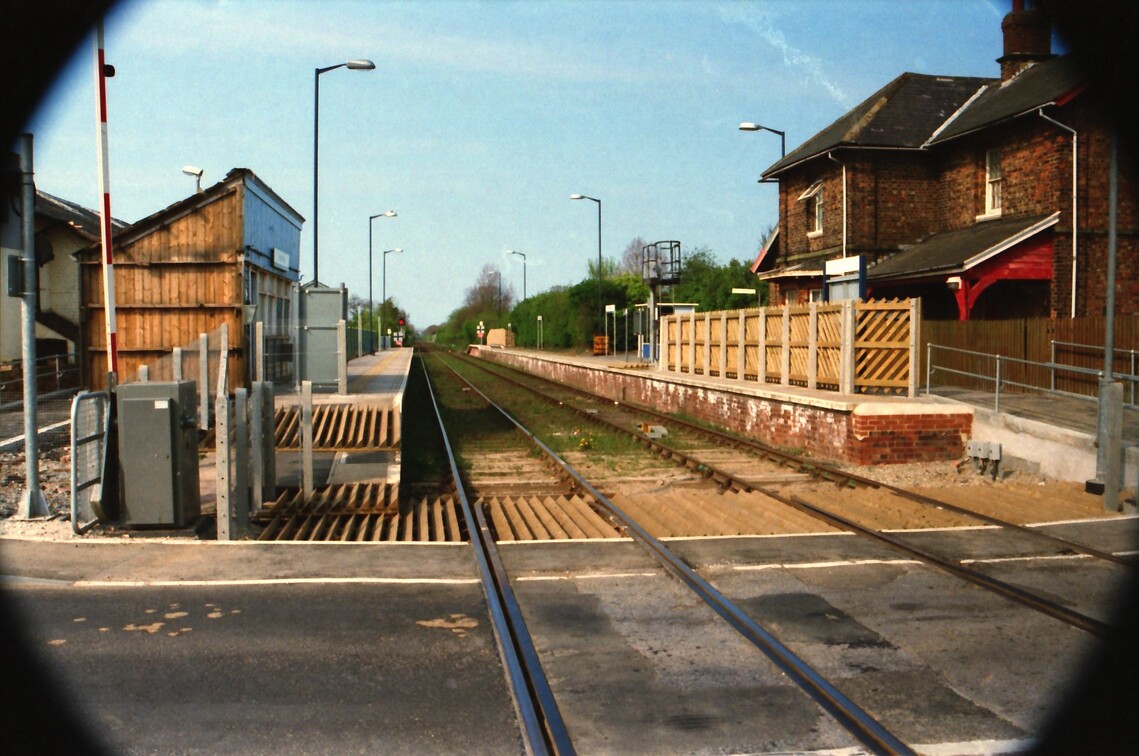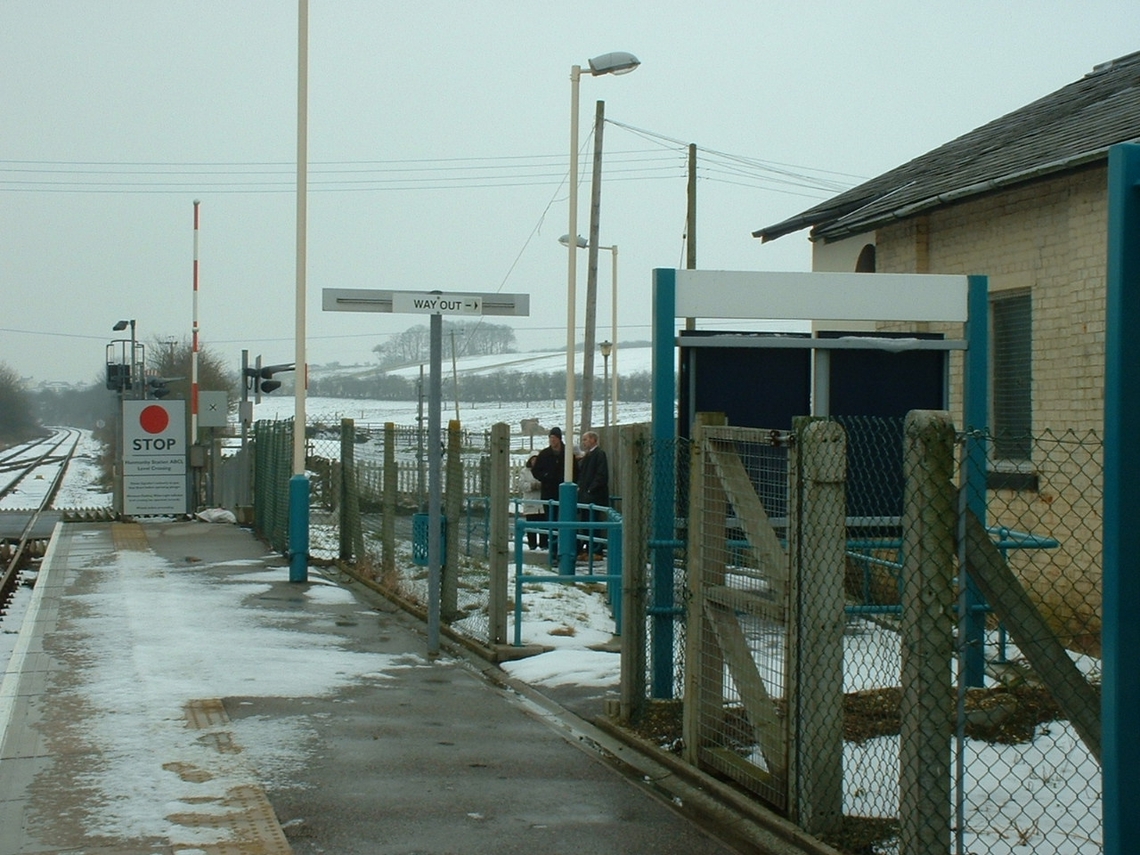How Hunmanby Railway Station changed through time
Hunmanby was a staffed station, the main business was not passengers but carrying goods by rail. The station had two railway warehouses, a separate siding and platform for moving animals. A coal yard and sidings to the brick works.
There are few photographs of the village station available on the Internet. If you have a personal photograph you would like to display, especially from yesteryear (BR old school) or earlier! it would be gratefully appreciated.
1896
An early map of Hunmanby. It has been suggested that the railway line is distant from the village due to the Lord of the Manor wanting to keep the railway line away from his property. The old road from Hunmanby onto the Wolds along Garton Lane had been closed with the building of New Hill. This is clearly show, 1st turning on the left from the station going towards the village along Bridlington Street. The large rectangular piece of land started development as a Motte & Bailey built by the Normans, and subsequently Hunmanby Hall was developed on the site with the adjoining park land.
1908
Below, with permission from the National Railway Museum in York, who kindly obtained a photo during lockdown of this item. The item is preserved in their archives and was donated by British Railway, with the reference 2003/9001 (perhaps in 2003?). It is in a glass frame and was made by the North Eastern Railway and dated 26th November 1908. It shows the sidings to the Coal Drops, shaded in light blue, these would have been signalled from the Signal Box at the railway station. Depots Crossing being operated by crossing keepers. The diagram shows the old semaphore signals. The coal drops still exist and are still used by S. Wilcock coal merchants who continue to operate from the Coal Yard. Depots Lane is now called Sands Lane. The East Riding Council depot being closed following re-organisation of local government in 1974.
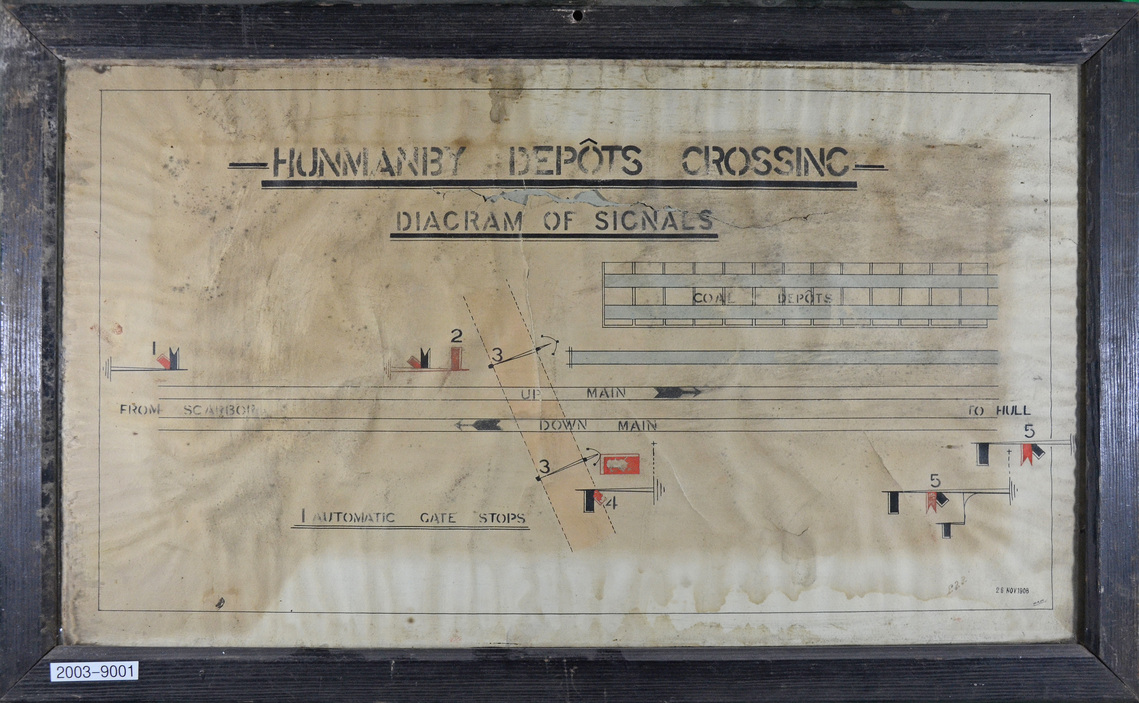
1926
Below is a map of the Hunmanby Railway Station in 1926. The line from Hull to Scarborough was then owned by the London & North Eastern Railway Company. There is a short goods loop to the small, raised platform, built for loading animals on the Bridlington side of the crossing. Then, alongside the Scarborough platform is a long siding that gives access to the two goods sheds. The brick works is shown having its own separate independent rail system. This has its own Northern Eastern Railway Siding to the North of the Station, where two further sidings serve the coal yard staithes.
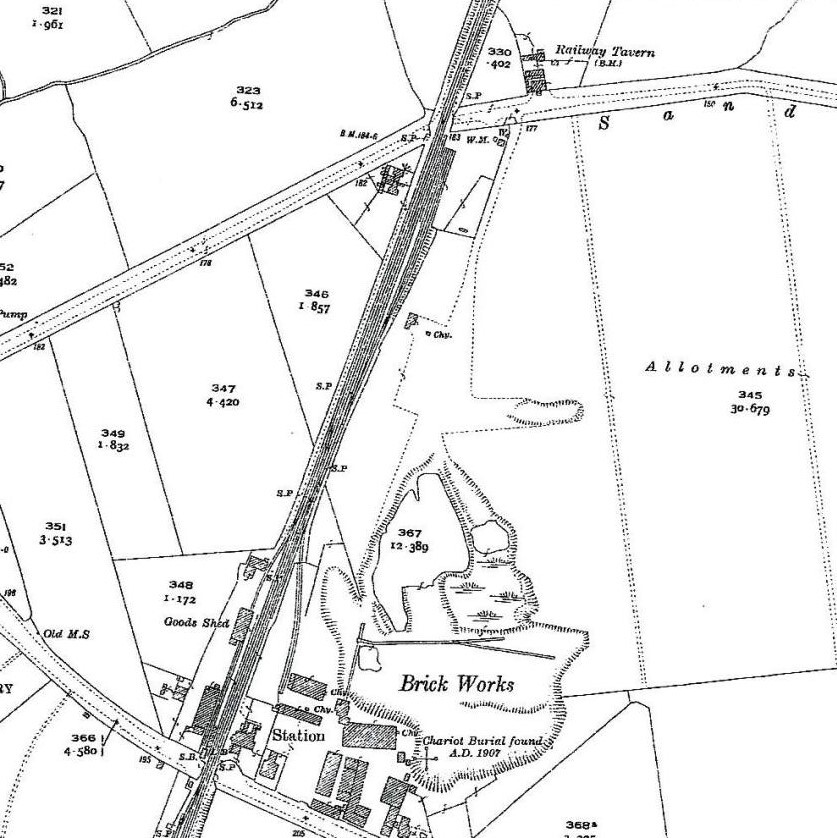
1930's?
The picture below probably taken before the Second World War in the 1930's. Looking towards Bridlington, with gas lighting, telegraph posts, milk churns waiting on the platform, and old traditional railway benches made of cast iron and wood on both platforms. Point work connects the two tracks to enable shunting of goods wagons at the station.
1939
The Yorkshire Coast Railway line became a popular destination for excursion trains. The Victorians developed the seaside resorts of Bridlington, Filey, and Scarborough. Below are some old railway handbills of some of these trains, from 1939, a few months before the start of World War II. The London & North Eastern Railway Company own the railway line at this time. Thank you to Carl Pollitt & Margaret Hey (Bolton) for donating them. Several are now displayed in the Old Station Waiting Rooms at Hunmanby Railway Station.

Peace returns 1945
The railways were important for the war effort but suffered and were in a poor state when the Big 4 Railway companies took back control. Hunmanby, like many rural railway stations, during the 'Golden Age of railways' was served by few passenger trains. Though car ownership was very low, ordinary people travelled much less than today. The railways carried most of the goods people needed and each station had a yard served by the daily pick up goods train.
The bitter winter of 1946/47
The photographs above and below are believed to be from the Malton-Driffield line near to Burdale, about 18 miles from Hunmanby, when Winters were Winters. As well as the heavy snowfall, and the depth of the drifts, they also show working conditions at the time. Rail Staff have no High Visibility protective clothing, they are shovelling by hand, and will be going home, after a long arduous shift, to no double glazing or central heating. The railways were vital to the country keeping goods and people moving, there were no motorways. 75 years ago, far more people worked on the railway, wages were often poor, hours long. Britain was slow to phase out the dirty steam engine, while it is easy to look back with rose tinted glasses, it was a hard life, which effected many a person's long term health. The railways needed to cut costs, with the expansion and rapid improvement to the road network. This was especially so in rural areas, where the rail industry was in sharp decline, struggling to modernise. Though in times of adversity such as during heavy snow far more members of staff were available locally, and the railways remained a lifeline for goods and people, few working families owning a private car. More photographs welcome.
These two photographs date from the bitter winter of 1947, when many lines across the north of England were closed for weeks, by heavy snow and sub-zero temperatures. With the pick and shovel providing the main stay of snow clearance, this was hard slow work for the gangs of railwaymen that battled to keep the arteries of the country open. Some large snowploughs were used, operating back-to-back, with two or three locomotives coupled together in between. They would charge a deep drift of snow until the amount of compacted snow and ice would bring the plough to a halt. The train would then run back, only to repeat the charge again and again, until the length of the drift had been cut with snow piled high to the sides. This did of course cover the adjoining track, but single line working could resume. The views are believed to be on the former Driffield to Malton line, (closed back in 1958). Photos thanks to Shirley Franklyn.
1947
Timetable World have kindly put on the internet a copy of the last timetable for the old London North Eastern Railway Company from June 1947.
What a difference the passenger train service was in 1947 at Hunmanby Railway Station
Monday to Friday 5 trains to Scarborough, and 6 Trains to Hull
Saturday 6 trains to Scarborough and 8 trains to Hull
Sunday 2 trains to Scarborough and 2 Trains to Hull
Full details at the timetable world website (The Hull to Scarborough service is Table 108) Just 3 years after the end of World war II, In 1948, the 4 private railway companies were Nationalised.
1950's
The opening of Hunmanby Hall Girls School in 1929, added to passenger numbers with pupils coming from across the country, their families, and staff. This is a picture taken in the 1950's showing the number of pupils waiting to catch the train on the Scarborough (down) platform. Thank you to Hunmanby Hall Old Girls Association for allowing use of their photograph.
By the 1950's Steam Traction was dated. Continental Europe, being rebuilt from a decade of conflict, was leading the way in Diesel and Electric power.
The result on 1st December 1954 was 'The Modernisation and Re-equipment of British Railways' known as the 'Rail Modernisation Plan'
Link to the Railway Archives
However, losses on the Nations railway still increased, faced with rising competition from private motoring and road haulage. However, the Yorkshire seaside towns are still busy in the summer season with excursion trains.
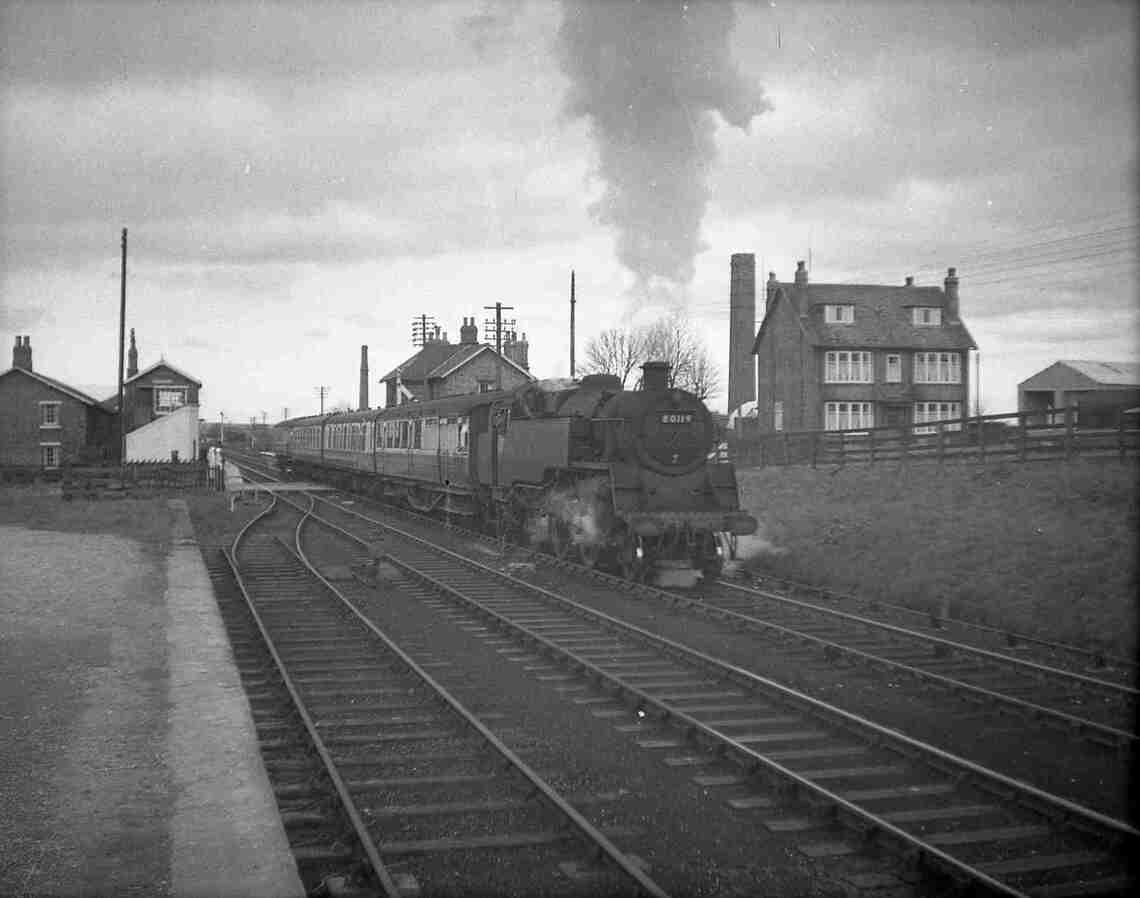
Photo above Class 4MT Locomotive Number 80119, hauling a local train away from Hunmanby to Hull in the 1950's. Note the brick works chimney, still standing along with the catch points and goods siding to the cattle dock siding. These 2-6-4T Locomotives were introduced by British railways in 1951, designed at Brighton. With the rapid run down of steam in the 1960's locomotive 80119 was withdrawn from service after just 14 year's service. The photograph was taken by the late Tony Ross, Further details from the webpage a tribute to Tony Ross.
Thank you to the North Eastern Railway Association for kindly allowing the photo to be used on this page.
Further details from Wikipedia BR Standard Class 4 2-6-4 Tank Locomotives webpage
This old railway hand bill below, was again kindly donated it shows an excursion train running on 2 consecutive Sundays by British Railways from Wadsley Bridge (near Sheffield) in July 1959. Thank you to Carl Pollitt & Margaret Hey (Bolton) for donating them. One of several that are now displayed in the Old Station Waiting Rooms at Hunmanby Railway Station.

1960's
This led to Ernest Marples the Minister for Transport to publish 'The Reshaping of British Railways' (more commonly known as 'The Beeching Report'
The days of many rural branch line, village and small-town stations were numbered.
Photograph above a steam train heading towards Filey and Scarborough, perhaps from the early 1960's?
To give an idea of how a rural station operated on the cusp of the implementation of the 'reshaping' these links to the Yorkshire Film archive give an idea.
The first is of Market Weighton railway station in East Riding taken in 1965 prior to and shortly after closure of the line. Market Weighton would have been around 3 times the size of Hunmanby. But the film footage gives an indication of the staff employed on the railway at that time, operation of the coal yard and a rural country station
link to Yorkshire Film Archive
1964
Photo above, Type 2, Class 31 diesel locomotive hauls an 8 coach train north through Hunmanby, the likely destination is Filey Holiday Camp. Introduced from 1957, and given the 'D' prefix' for Diesel, 'E' was for Electric. The livery is two tone green, which suited these Brush built locomotives. In 1964 the line is still double track all the way to Hull. The photograph was taken by the late Tony Ross, Further details from the webpage a tribute to Tony Ross Thank you to the North Eastern Railway Association for kindly allowing the photo to be used on this page.
Further details about these Type 2 Diesel locomotives on the wikipedia webpage
The Excursion trains and extra services being provided at times of high demand continued, as the railways were still popular taking people from the northern industrial towns to the Yorkshire Coast. (With the offer of cheaper fares by travelling at off peak times to spread demand. The poster, below, for Easter Monday 1964 between Hull, Bridlington, Filey, and Scarborough. Thank you to Carl Pollitt & Margaret Hey (Bolton) for donating them. One of several that are now displayed in the Old Station Waiting Rooms at Hunmanby Railway Station. A key date for Hunmanby Railway Station is 1964, on 10th August, the Goods Yard closed.

1968
The photographs below are from the Historical Model Railway Society Collection, a registered charity formed 70 years ago. If you would like copies, they can be obtained for a small charge through this link to the Historical Model Railway Society. The website has an amazing collection of archived photographs free to view. The Charity would welcome donations of old railway photographs, so the countries railways history can be recorded. The series of photographs below are from the John Bateman collection. Friends of Hunmanby Railway Station are grateful to the Historical Model Railway Society for permission to use on this website. The actual photographs were put on display at Hunmanby Heritage Day on 11th September 2021, David, a local photographer kindly took modern day photographs to show the changes. The display will again be used as part of the 175th Anniversary of the Hull to Scarborough line to give a presentations to community groups in the village.
Photo above: Taken on Tuesday 20th August 1968, from the John Bateman Collection, thank you to the Historical Model Railway Society for allowing the photograph to be displayed. Note the station house with the poster boards they still have their 'British Railways' enamel signs. The station looks tidy, with all the poster boards displaying posters.
May 1969
Having survived the first wave of line and station closure in the mid 1960's. Lines continued to be put forward for closure. 1969 was a bleak year for the whole line as plans were published to withdraw the passenger service, not just at Hunmanby and Filey, but the whole route from Hull to Scarborough, via Beverley, Driffield and Bridlington. It is tribute to those who campaigned and attended the public inquiry that the railway line is still open, and 50 years later has the best services in its history.
Photo above is from the May 1969 to May 1970 Eastern Region British Railway Timetable, kindly donated by Peter in Staffordshire. It shows how basic the year-round service just one train called at Speeton, and 7 trains at Hunmanby going to Scarborough, with one extra service between 9th June and the 5th September, which called at both Speeton and Hunmanby.
Photo above, a warning was placed in the Eastern Region Timetable for the year May 1969 to May 1970, that all station may close during the currency of the timetable.
Thursday 7th August 1969
The photograph above is from the John Bateman Collection, thank you to the Historical Model Railway Society for allowing the photograph to be displayed. Perhaps John returned to the line in 1969, to capture Hunmanby railway station and the rest of the stations on the line from Filey to Cottingham as they were put forward for closure by British Railways May 1969. The photograph above is of the front of the former signal box and former timber waiting room on the down platform. Much of the exposed woodwork is exposed to the elements, the paint having peeled off. There is an air of dereliction in the air. Weeds are growing, though all windowpanes remain intact.
The photograph above is from the John Bateman Collection, thank you to the Historical Model Railway Society for allowing the photograph to be displayed. The view shows the old gates, the poor state of the paint work and the walkway still in existence around the signal box to clean what appears to be Yorkshire Slider Windows. A few examples still exist in some of the older chalk properties in Hunmanby village.
The photograph above is from the John Bateman Collection, thank you to the Historical Model Railway Society for allowing the photograph to be displayed. The small timber on the opposite side of Bridlington Street from the Signal Box. Was this used to store parcels? Following the closure of the goods yard in August 1964, Hunmanby continued to be used for parcel traffic until 1974.
The photograph above is from the John Bateman Collection, thank you to the Historical Model Railway Society for allowing the photograph to be displayed. A clear view down the line through the crossing gates. Note the foot crossing on the other side of the crossing gates. At each end of the foot crossing were a set of gates.
The photograph above is from the John Bateman Collection, thank you to the Historical Model Railway Society for allowing the photograph to be displayed. Next to the signal box was the old North Eastern Railway waiting room. The neglect is apparent. The photo clearly shows the walkway around the signal box. The concrete posts and concrete paving slabs were removed and replaced in more recent times, and used to infill the gap left from the removal of the goods siding to W. Page's former warehouse, that still stands next to Platform 2. The porters sack cart, a couple of broken wheels were found a decade ago when putting in a flower bed at the station.
The photograph above is from the John Bateman Collection, thank you to the Historical Model Railway Society for allowing the photograph to be displayed. This view shows the access onto the platform by the side of the former signal box.
Photo above, the Northbound, Down platform, from the John Bateman Collection, thank you to the Historical Model Railway Society for allowing the photograph to be displayed. The bench needs of painting, note the basic platform surface, the 'Hunmanby' sign remains in good condition, next to the gas lighting and the old goods warehouse with lettering.
The photograph above is from the John Bateman Collection, thank you to the Historical Model Railway Society for allowing the photograph to be displayed. It shows the former North Eastern Railway Gas Lighting Column, still with glass in place, and the W. Page or York in white lettering. This was the original rail served goods warehouse, completed by the York & North Midland Railway in March 1853, which was let for £25 per annum to Messrs Dawson. The 'Dawson' warehouse was later leased to William Page of York a corn and seed merchant. (Information thanks to the North Eastern Railway Association, and their detailed book 'A history of the Hull and Scarborough Railway' Edited by John F. Addyman and Bill Fawcett.)
The photograph above is from the John Bateman Collection, thank you to the Historical Model Railway Society for allowing the photograph to be displayed. This view shows in the background the start of the new housing estates in Hunmanby from the late 1960's. In the foreground is later goods shed built by the York & North Midlands. A contract was let in March 1853, to Mr Hall to build it. (Information thanks to the North Eastern Railway Association, and their details book 'A history of the Hull and Scarborough Railway' Edited by John F. Addyman and Bill Fawcett.)
The photograph above is from the John Bateman Collection, thank you to the Historical Model Railway Society for allowing the photograph to be displayed. The shot through the old wooden level crossing gates show the position of the 3 gas lighting columns, and an air of neglect. The former rail connected York & North Midland goods warehouse in the background, and goods yard has seen now work for 5 years.
The photograph above is from the John Bateman Collection, thank you to the Historical Model Railway Society for allowing the photograph to be displayed. A 3- coach 1st generation diesel multiple unit is approaching Hunmanby from Scarborough. Travelling to Hull. It is likely to be the 11:52 departure. The previous train having left at 7.26am and the subsequent train is at 15:08 which in the height of summer 9th June1969 to 5th September 1969 will be a through train from Leeds City via Scarborough to Hull. (Information from the Eastern Region, British Rail Passenger Timetables donated by Peter in the West Midlands)
The photograph above is from the John Bateman Collection, thank you to the Historical Model Railway Society It is taken looking towards Bridlington. I the background, the view has not changed. There has been no development even to this day on the opposite side of the level crossing.
The photograph above is from the John Bateman Collection, thank you to the Historical Model Railway Society for allowing the photograph to be displayed. The fence belonging to the station house has clearly been painted, in sharp contrast to the British Railways fence. Perhaps the station house has now been sold? The hand -painted sign by the gate says 'No Parking'
Photograph above: The final shot (one of 14 taken by John Bateman at Hunmanby that day) from the John Bateman Collection, thank you to the Historical Model Railway Society for allowing the photograph to be displayed. There is a distinct air of impending closure. The 'British Railway' enamel signs have gone from the poster boards, which are neglected. It is late Summer, and weed are growing. Prominent in the main entrance to Hunmanby Station (what today is now the drive to the station house) note the old railway bench, still retaining an enamel 'Hunmanby' sign.
August 1970
Thankyou to the Railway & Canal Historical Society for allowing use of these 3 photographs, taken in 1970 from the Grahame Boyes collection. The Railway & Canal Historic Society welcome donation of photographs and help with their archive which is free to view. The You Tube video is well worth watching to help understand how to access the archive of over 40,000 images. Further details from their website Railway & Canal Historical Society Online Media Archive
The line has just been saved, but the neglect is apparent on the up platform, there is a 'Heath Robinson' construction to keep passenger out of the toilet, part of the overgrown flower bed will in a few years become space for a '1970's style' bus shelter to replace the fondly remembered old waiting rooms, with the tick tock of the clock and the coal fire.
The empty concrete flower planters look forlorn, the station still has its good array of Victorian Gas Lights and the wooden North Eastern Railway Benches remain. Hunmanby at this time is still a pick up and drop of point for parcels with the trolley near the up semaphore starter signal and a couple of porters trolleys. Does anyone recognise the old push bike?
1973
The second link is to Cottingham railway station, in 1973. Cottingham is on the Yorkshire Coast Railway Line, and though it has remained open, is now unstaffed. This again gives an idea of how a rural railway station operated and both the goods and passengers that were carried.
link to Yorkshire Film Archive
After watching the two films, this gives an idea of the rapid change on the railways since the mid 1960's.
A final film to suggested on the Yorkshire Film Archive is of what is now 'The Cinder Track' cycle way from Scarborough to Whitby. The film entitled 'A sentimental journey Whitby to Scarborough 1966' shows the last train on the line
link to Yorkshire Film Archive
1980
The above photograph was taken by the late Chris Woolstenholmes in 1980, who recorded the scene. The signal box and fencing has recently been painted. Note the new lighting columns have replaced the gas lighting. It is taken from a different angle and shows the 'Georgian style' windows in the back wall of the signal box. Friends of Hunmanby Railway Station are grateful for the permission of the North Eastern Railway Association as copyright holder to use the above photograph. Further details of this charity from their website The North Eastern Railway Association
July 1985
These photographs were all taken in 1985, a time when many railway stations especially rural ones, were seeing building demolished and tracks 'rationalised'. Though the station in 1985 looks far more welcoming than in 1969.
These days greater care is taken of our heritage.
This link is to Network Rail’s Heritage Highlights of 2019
and this is the link to Network Rails Heritage Highlights for 2020
In the 1980's if you took a photograph one summer, the Victorian railway architecture could well have gone the following year! Thank you to Carl Pollitt & Margaret Hey (Bolton) for donating them. Several of the posters are now displayed in the Old Station Waiting Rooms
These are the comments made regarding the photographs from 1985. Of the principal features shown, just the station house remains. Hunmanby Railway Station's wooden bench that the old 'bus shelter' was built around on the Hull bound platform, has now been restored. It became a 'lock down' project in the Winter/Spring of 2020 due to the COVID-19 pandemic. It is now back on the platform to Bridlington and Hull
The photograph below was taken in July 1985. The Signal Box was still in use. The view is to Bridlington of the 2-story main building on the Bridlington Platform. Note the bay window, covered entrance and clock on the
wall. This is now where a plaque has been put giving the date of the building of the station.
.jpg)
The photograph below, general view looking towards Bridlington
.jpg)
Below a similar view looking towards Bridlington
.jpg)
Photograph below a view of the Scarborough Line platform showing
the North Eastern Railway Signal Box and North Eastern Railway wooden waiting
shelter. Note the ground floor windows of the signal box.
.jpg)
Below the photograph shows the view towards Bridlington of the
Bridlington Line platform showing the main buildings, note the bay window.
.jpg)
Below the photograph shows the view Bridlington of the tall
North Eastern Railway Signal Box on the Scarborough platform. Note the ground
floor windows..jpg)
.jpg)
Photograph below the exterior view of the main buildings on the
Bridlington line side, looking towards Scarborough. Note the covered porch to
the former entrance..jpg)
1989
Above: Many thanks to Steve, who purchased this negative of Hunmanby Station on 29th August 1989, showing a 1st generation diesel multiple unit train comprising of 4 coaches arriving with the 17:15 service from Hull to Scarborough
1997
Below, Hunmanby station and level-crossing, 1997. Taken by the late Ben Brooksbank, retired Medical Scientist, keen photographer for nearly 75 years. Taken photographs, primarily of scenery and railways, in Britain and abroad, in colour since 1953 (slides, prints since 1980), digital since 2003). Lifelong Railway Enthusiast, in recent years concentrating on Closed Stations -- as well as Open ones. Several thousand photographs to offer, including over 1,000 b/w of Railway stations/remains (and 3,000+ of locomotive and train scenes) taken 1946-66); also, over 8,000 more recent colour photographs, including many of Stations. Scenery and other non-railway photographs cover the same period in comparable numbers.
A great site, link to: Ben Brooksbank on geograph
cc-by-sa/2.0 - © Ben Brooksbank - geograph.org.uk/p/3695142
January 2001
Last Days of Hunmanby's Old Signal Box, Traditional Crossing Gates and Wooden North Eastern Railway Buildings
The photographs below were taken of the old wooden station buildings and traditional signal box at Hunmanby, prior to being demolished. Thank you to local photographer David Milburn for recording the event and kindly donating the photographs.
Working starting on taking down the old railway station signal box on the 11th of January 2001. Arriving just in time with the Crossing Gates intact. Note the old wooden waiting rooms on the Scarborough platform. (Photo thanks to David Milburn)
Old semaphore signal still standing, view towards the railway station house (Photo thanks to David Milburn)
For an interesting film from the Yorkshire Film Archive, of how a signal box operated. This was taken in 1963 at the busy Walton Street Signal Box at Hull. There are some great shots of the old road traffic along with how many people travelled to work by bike from this era.
link to Yorkshire Film Archive
Old crossing gates now replaced with half-barrier; signal box has been demolished. The wooden waiting shelter clings on. New level access provided to both platforms suitable for access with wheelchairs. New colour light signal has replaced the old semaphore signal on the Hull platform. (Photo thanks to David Milburn)
A view onto the Scarborough platform with the new half-barriers, a rear view of the old wooden waiting shelter soon to be replaced by a more modern 'bus shelter' further along the platform. New path gives level access for wheelchair users onto the platform. (Photo thanks to David Milburn)
Photograph taken from the road crossing towards Scarborough. To compensate for the shortening of the Hull bound platform for trains, marked by the fence, an extension has been added in the far distance. (Photo thanks to David Milburn)
Winter 2005/2006

A photograph from the Winter of 2005/06 a very bleak blank canvas to work with to improve the attractiveness of the village railway station, no flowers!
2006 to 2016
The train services through Hunmanby, had remained largely, unchanged for since 2005 with an irregular service roughly every 90 minutes. The Yorkshire Wolds Coast railway line station tended to be served Class 158, 2 car trains. These were a well-designed diesel multiple units, built by British Rail Engineering Limited, at Litchchurch Lane, Derby. Between 1989 and 1992.
The last year of the 1980's had been the turning point in the fortunes of the nation's railways, especially rural lines. 1989 saw the end of plans to close 'unprofitable' railways, and an end to the uncertainty of rail reviews, looking at further rationalisation. 1982 has now been regarded as its the nadir, revenue down, losses at record levels and a costly industrial dispute, it was also the year of the publication of the Serpell Report.
With the world-famous Settle -Carlisle Railway saved from closure, especially for rural lines they started to be looked upon as assets for the settlements they served, and community involved was encouraged. The Class 158 units transformed travel on Regional Routes such as the Trans-Pennine Corridor, in the 1990's to Scarborough, Hull, Newcastle, Liverpool and Manchester, they even had an on-board telephone. A big move forward from the 'pacer' trains. It was the start of a better design of rolling stock to provide a viable comfortable alternative to the private car and the increasing road congestion around the large town and cities. Passenger number rose dramatically, especially on inter urban routes. When larger trains were needed to replace the Class 158 units, these well-designed trains were transferred to work the Yorkshire Wolds Coast Line where they proved very popular
The Franchise, for the Northern Rail services was run by Serco-Abellio from 2004 to 2016. Passenger numbers were not expected to grow. (The important Inter- Urban routes had been put into the Trans-Pennine Franchise.) So, it is to Serco-Abellio credit, that they worked the assets they had hard and took the risk to add extra services. Passenger numbers sored, but there was little money for more trains, a huge capital cost. The first service improvement for many years, for Hunmanby, was the introduction of a year-round, (rather than holiday season) Sunday train service. Passenger numbers were now rising...
2019 to Coronavirus (COVID 19)
When a New Northern Franchise was drawn up to start in 2016, instead of planning for 'no growth'. The Department for Transport wanted to expand and improve train services dramatically in the North, based on this success. It was not to be just trains but also to transform the quality of service for passengers. Even Hunmanby, a low use rural station would have new waiting shelters, real time information, new signs, CCTV, and more modern trains. Northern Rail were to have finance set aside to support community involvement. The period between 2018 and 2020 has seen these improvements rolled out. During this period different diesel multiple units appeared on the local line. This was due to trains being taken out of service to have a complete rebuild and moving trains to different parts of the network, to plan for the increased passenger demand. Alongside this Network Rail spent several £ million on track improvement and Northern Rail contractors set to work on Hunmanby station fay 2019 saw the introduction of the new hourly, 7 day a week timetable with earlier and later train. Passenger number rose sharply,43% at Hunmanby between 2018/19 and 20189/20. The service had just settled down into a regular, 3 coach Turbo Star trains being used on the new hourly Scarborough to Sheffield route, when the Coronavirus (COVID 19) pandemic arrived.
This forms the background to the link below to the album of local photographer David Milburn
link to David Milburn Album on Flickr
(Even the local Hunmanby rabbit features that helps to prune the station plants.)
Updated 28.10.2021

